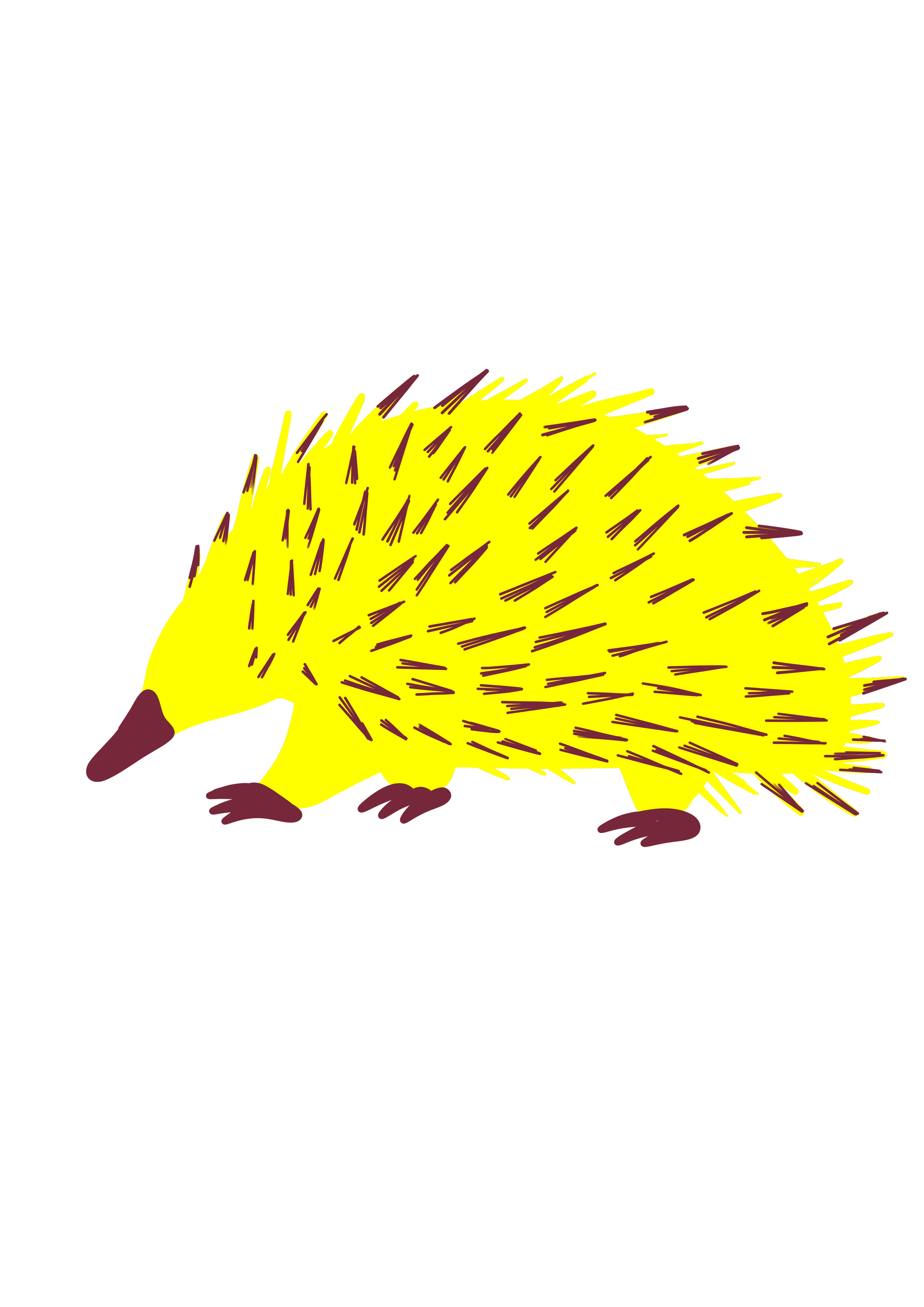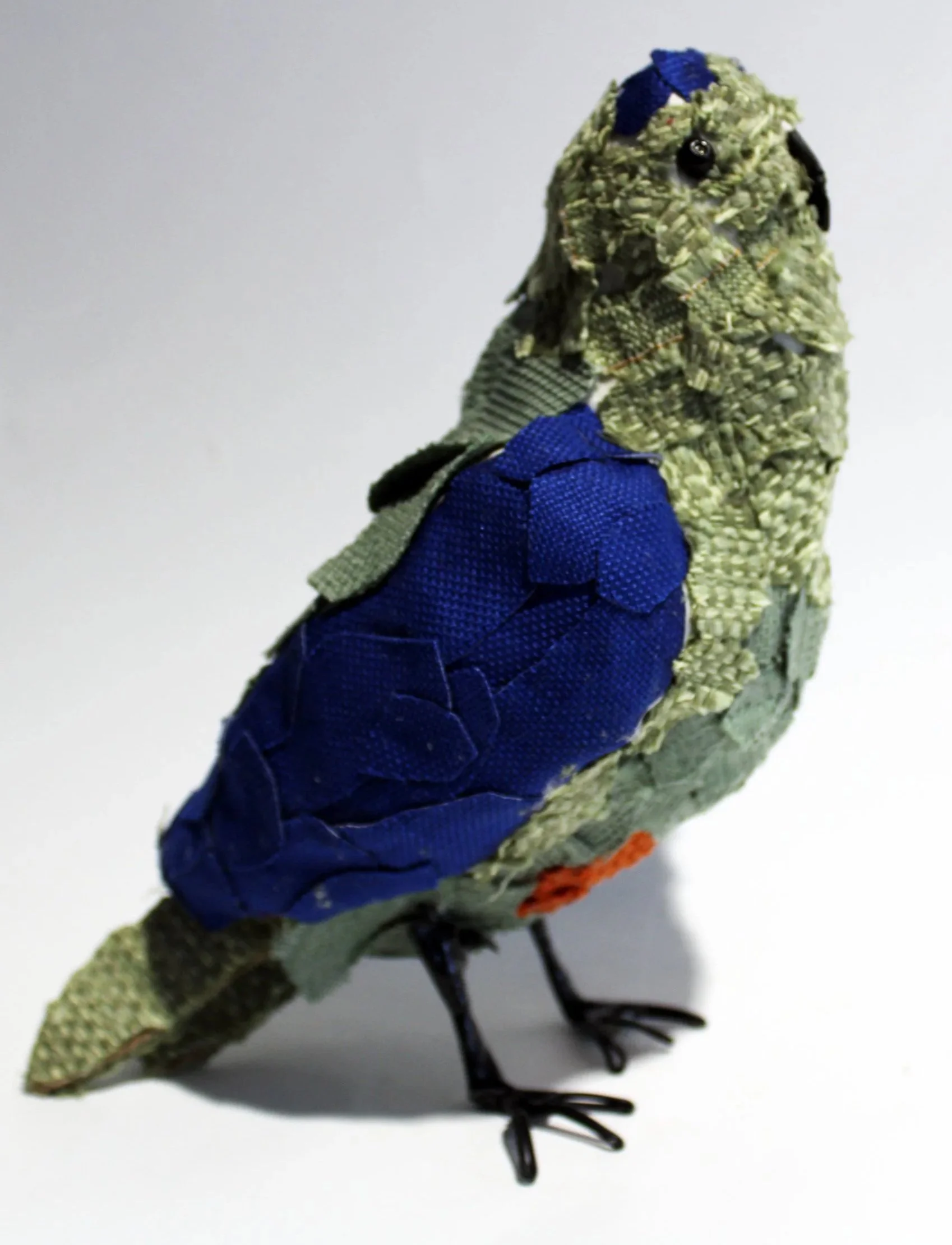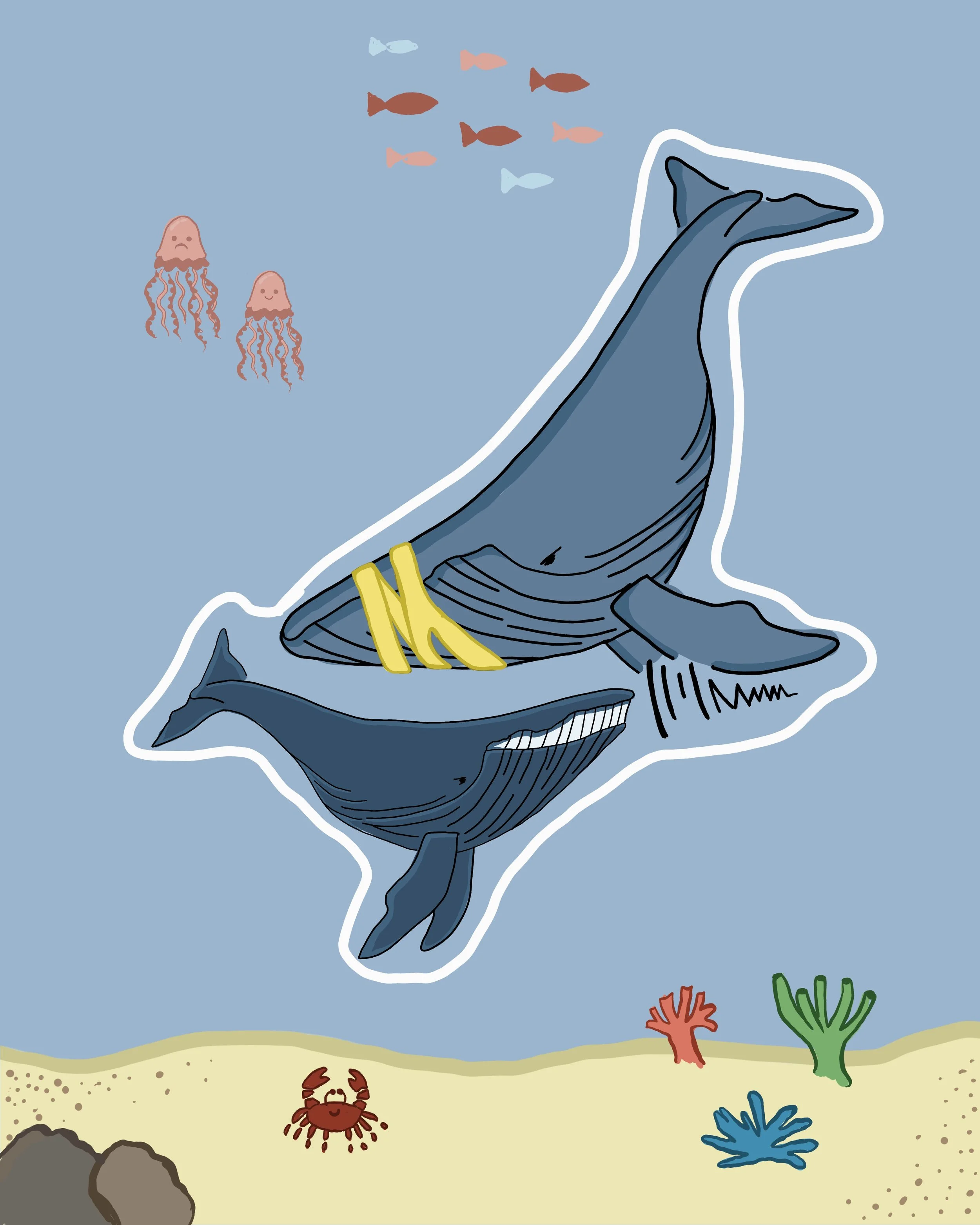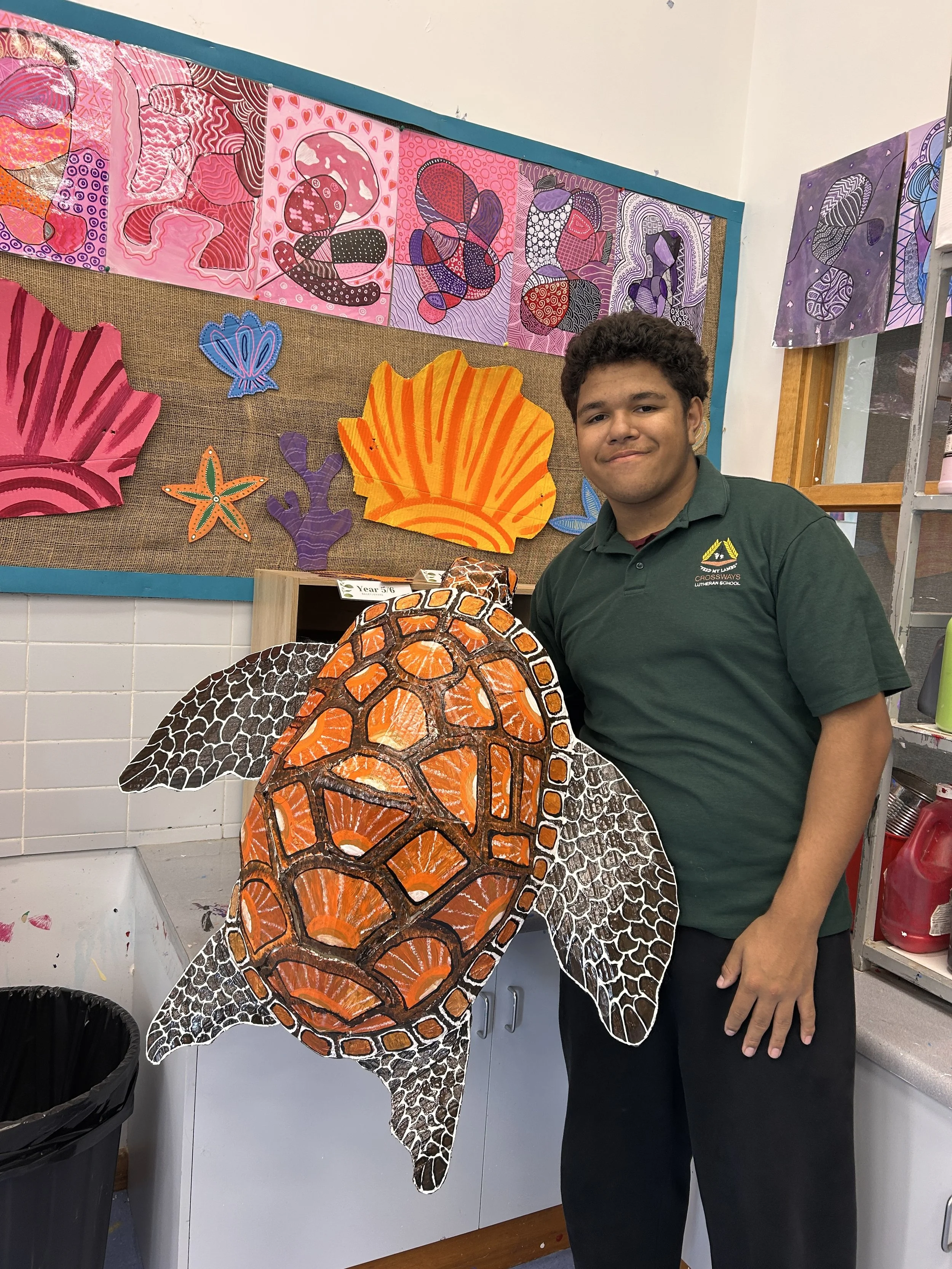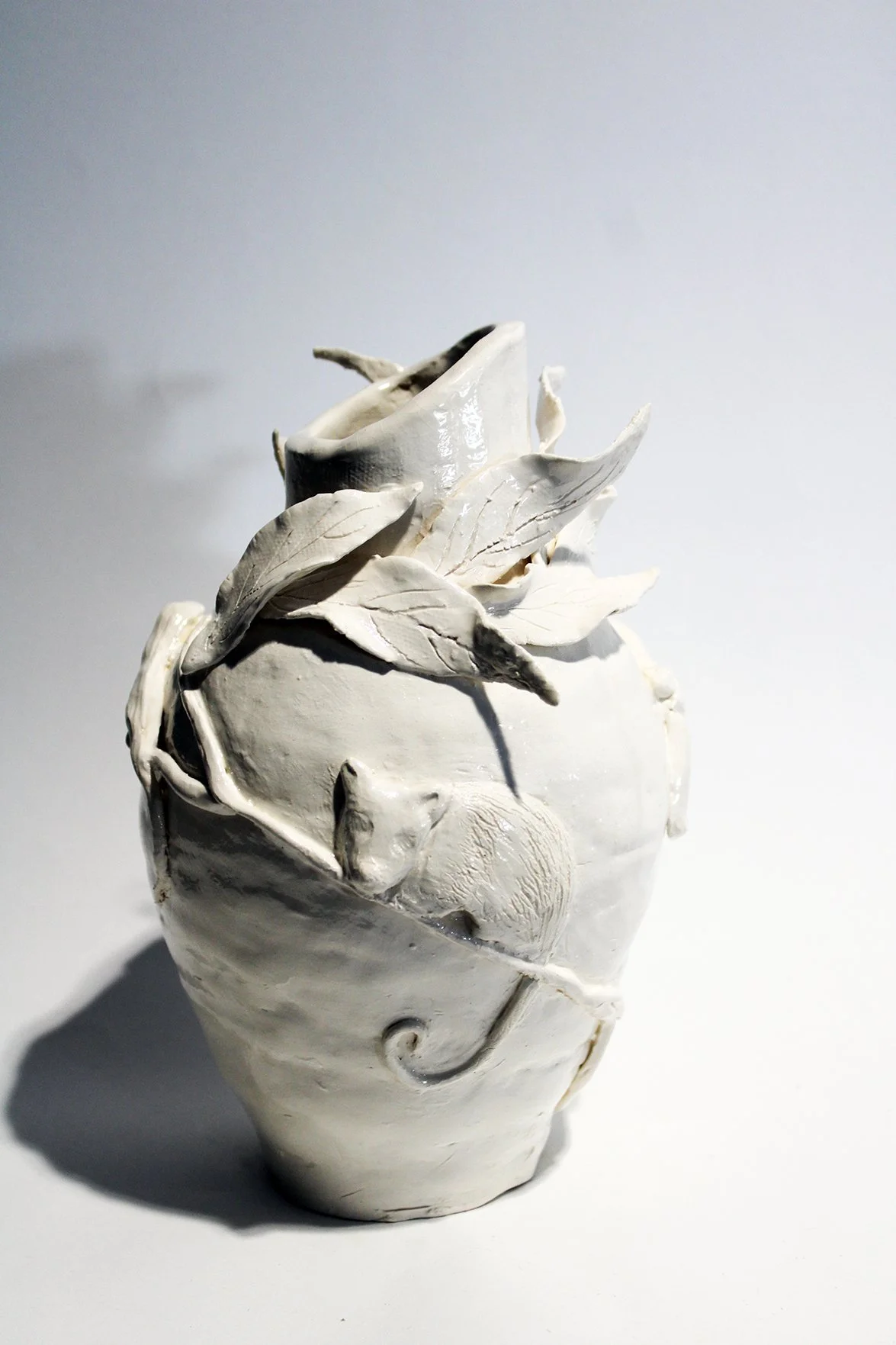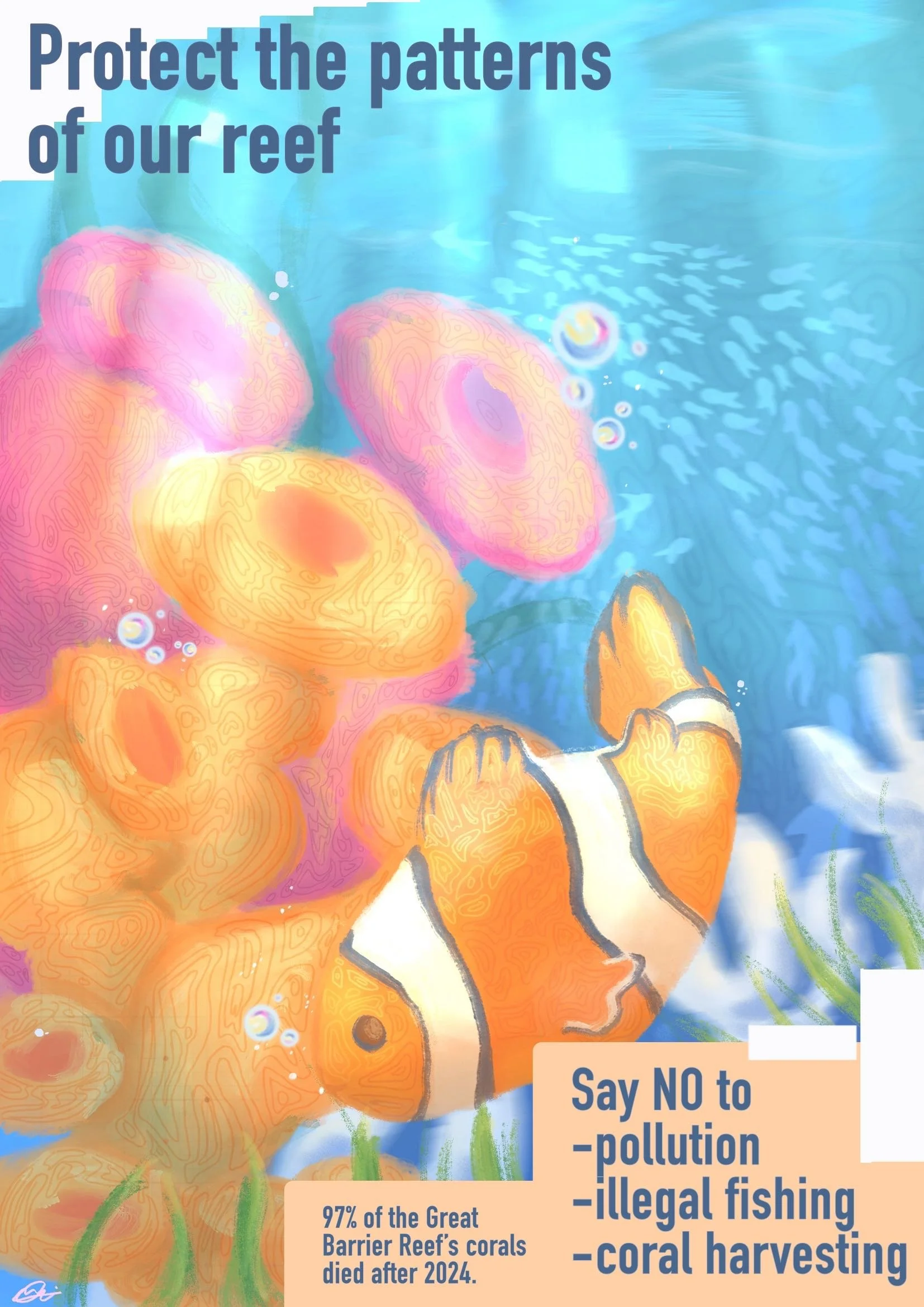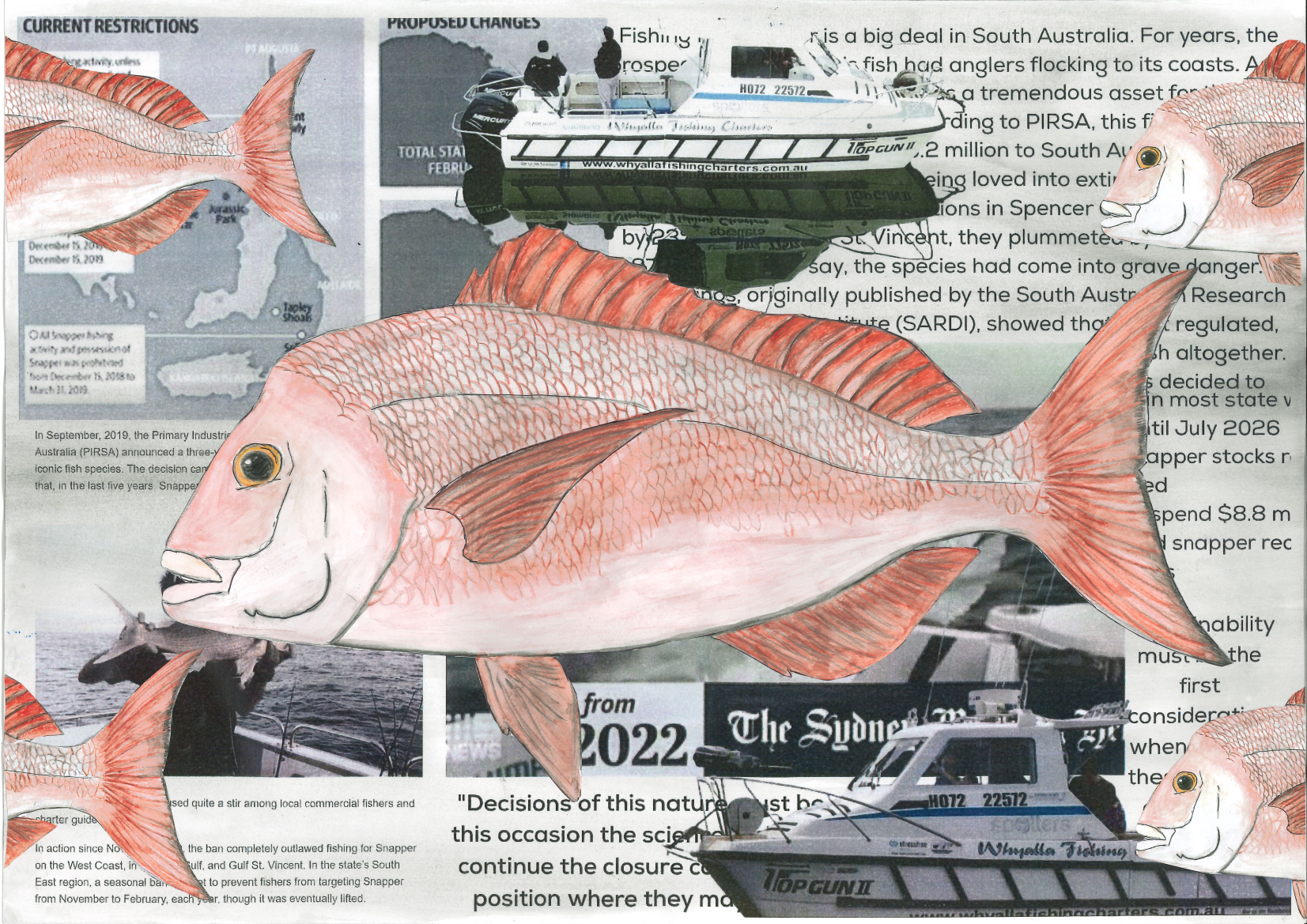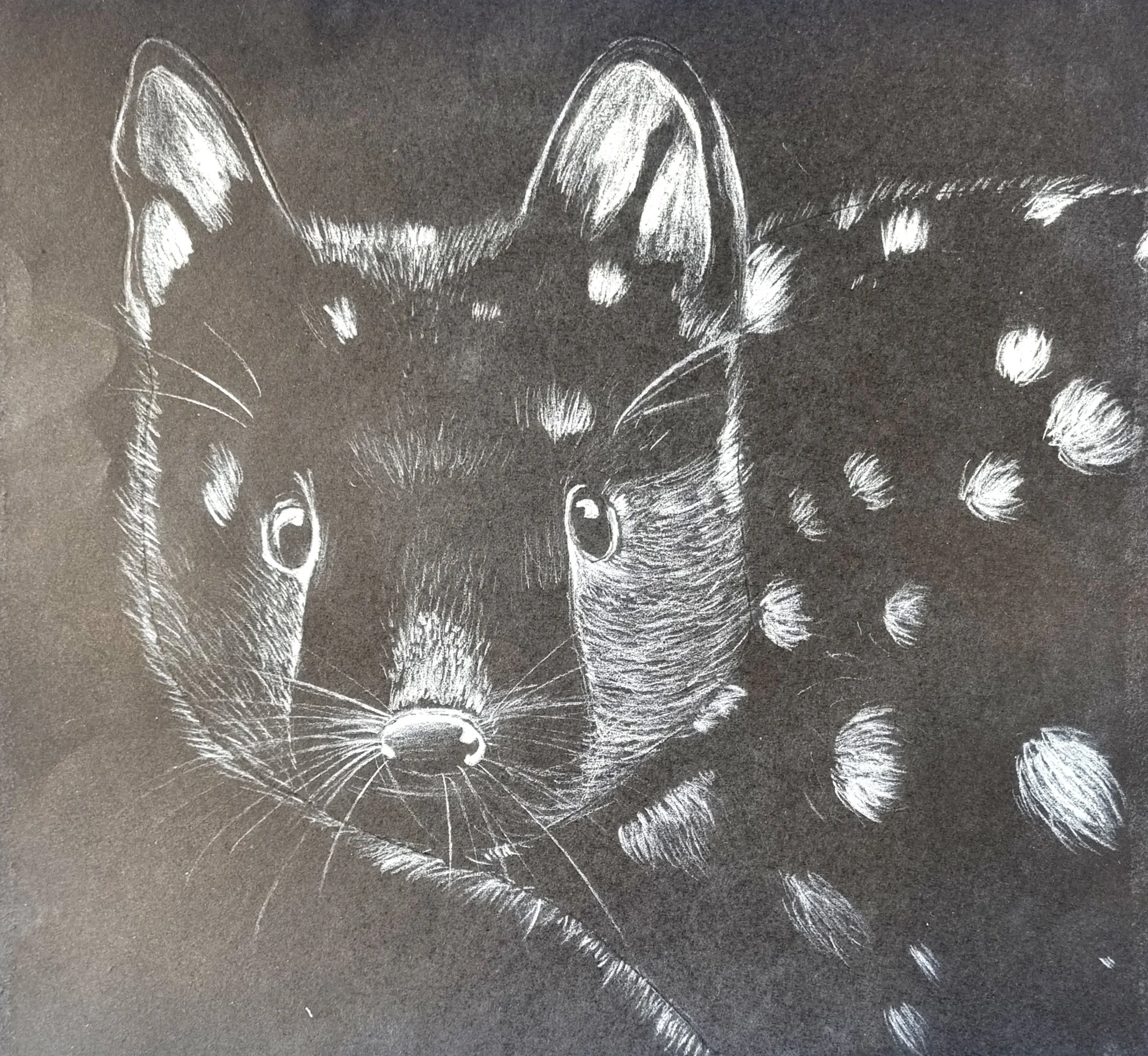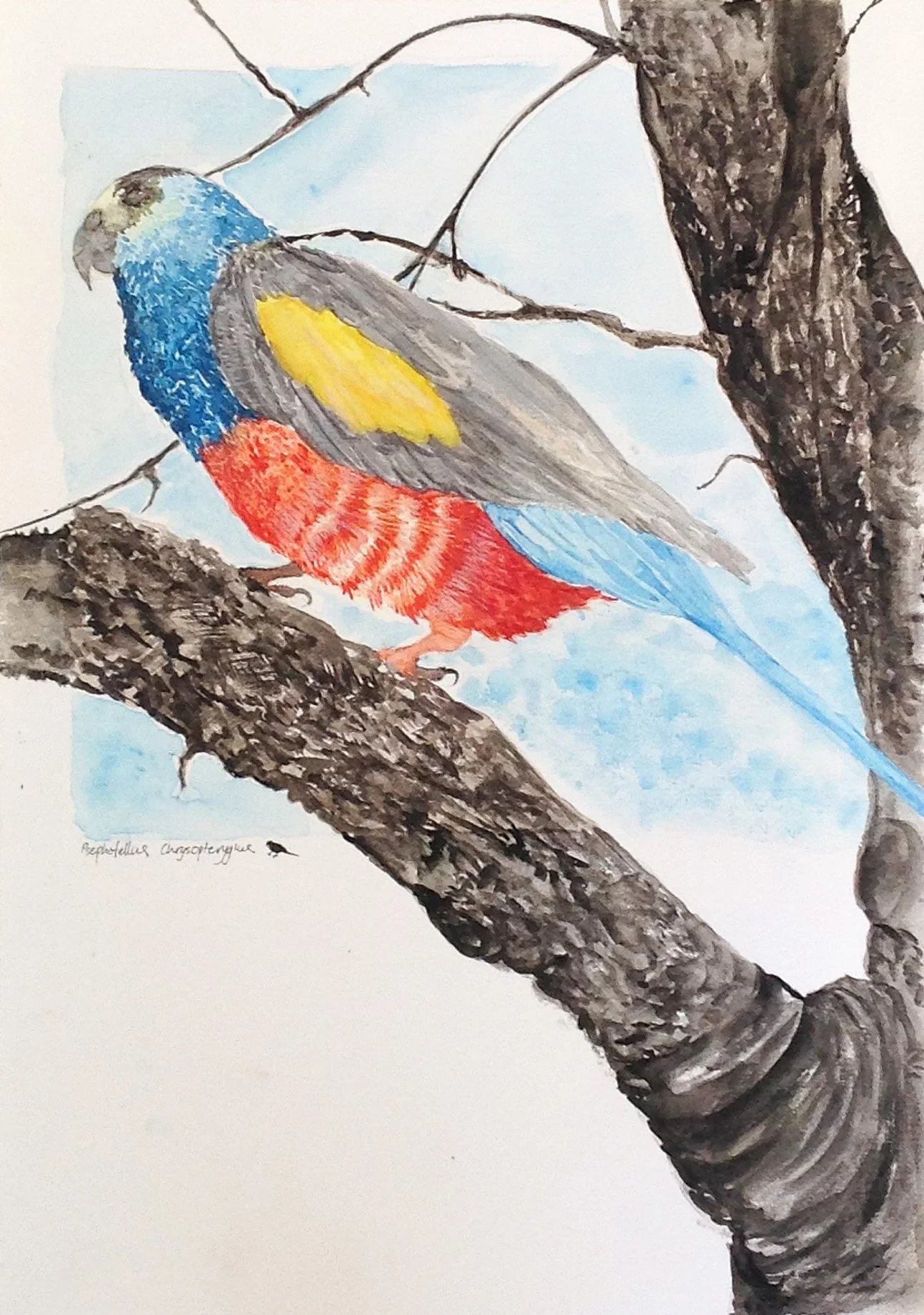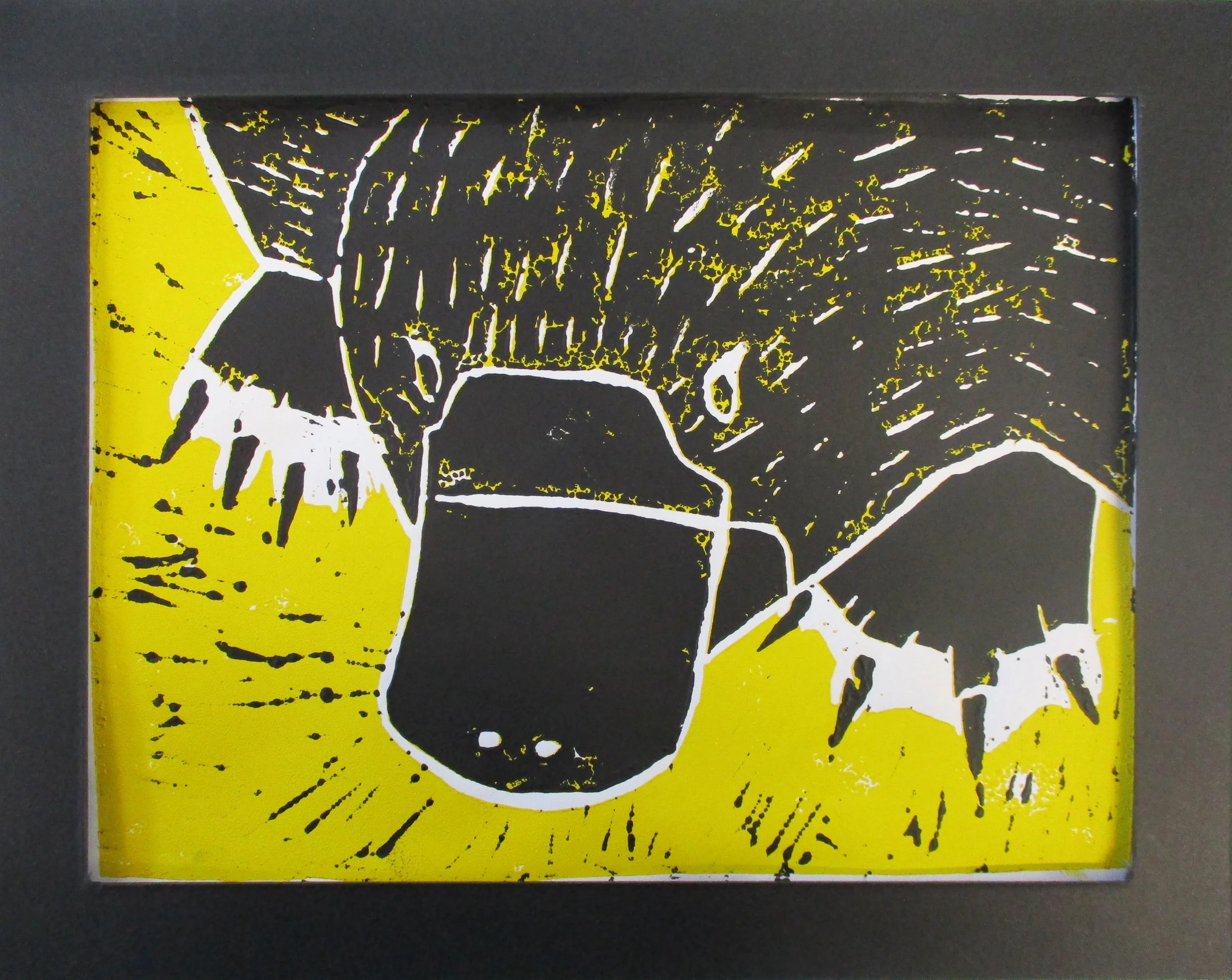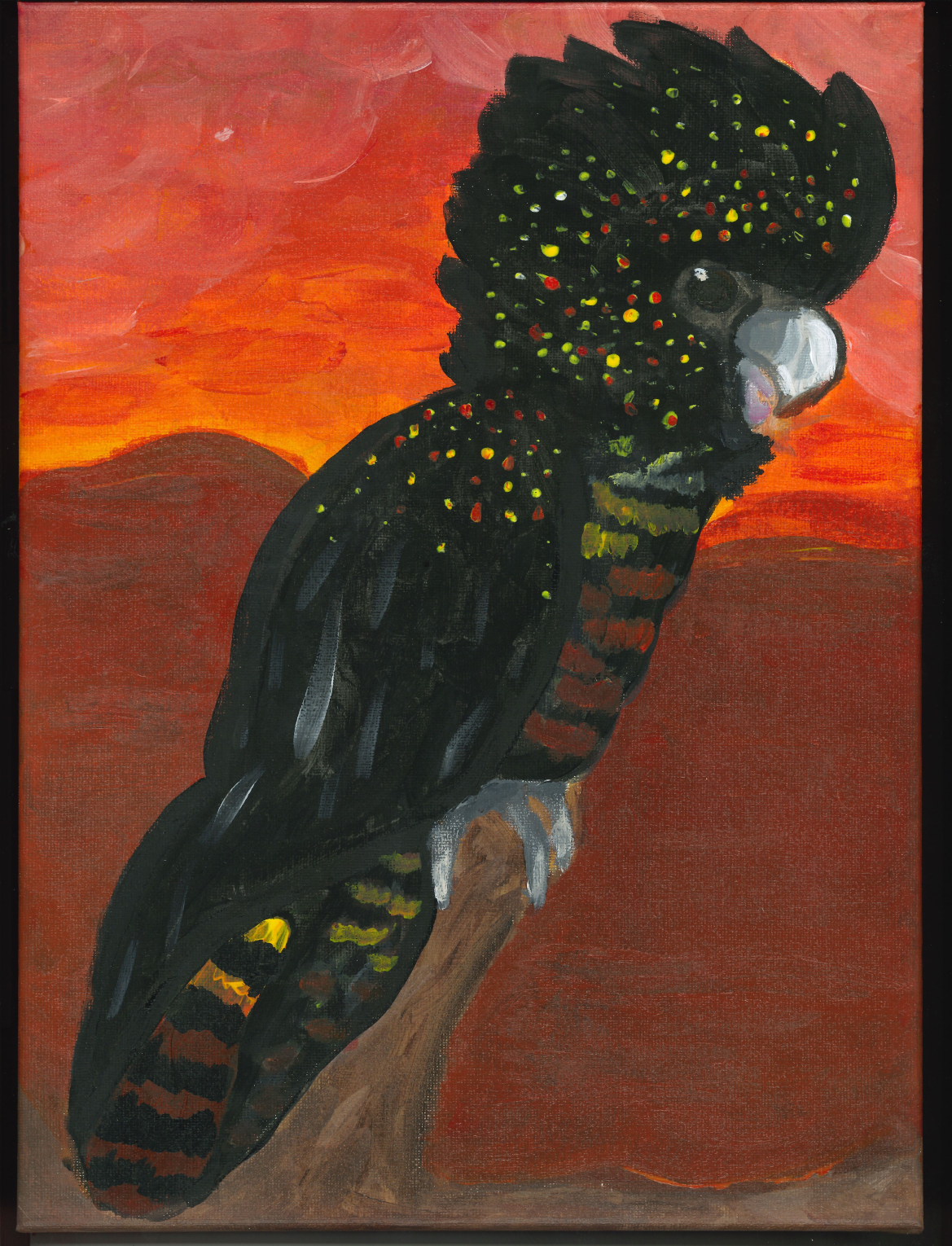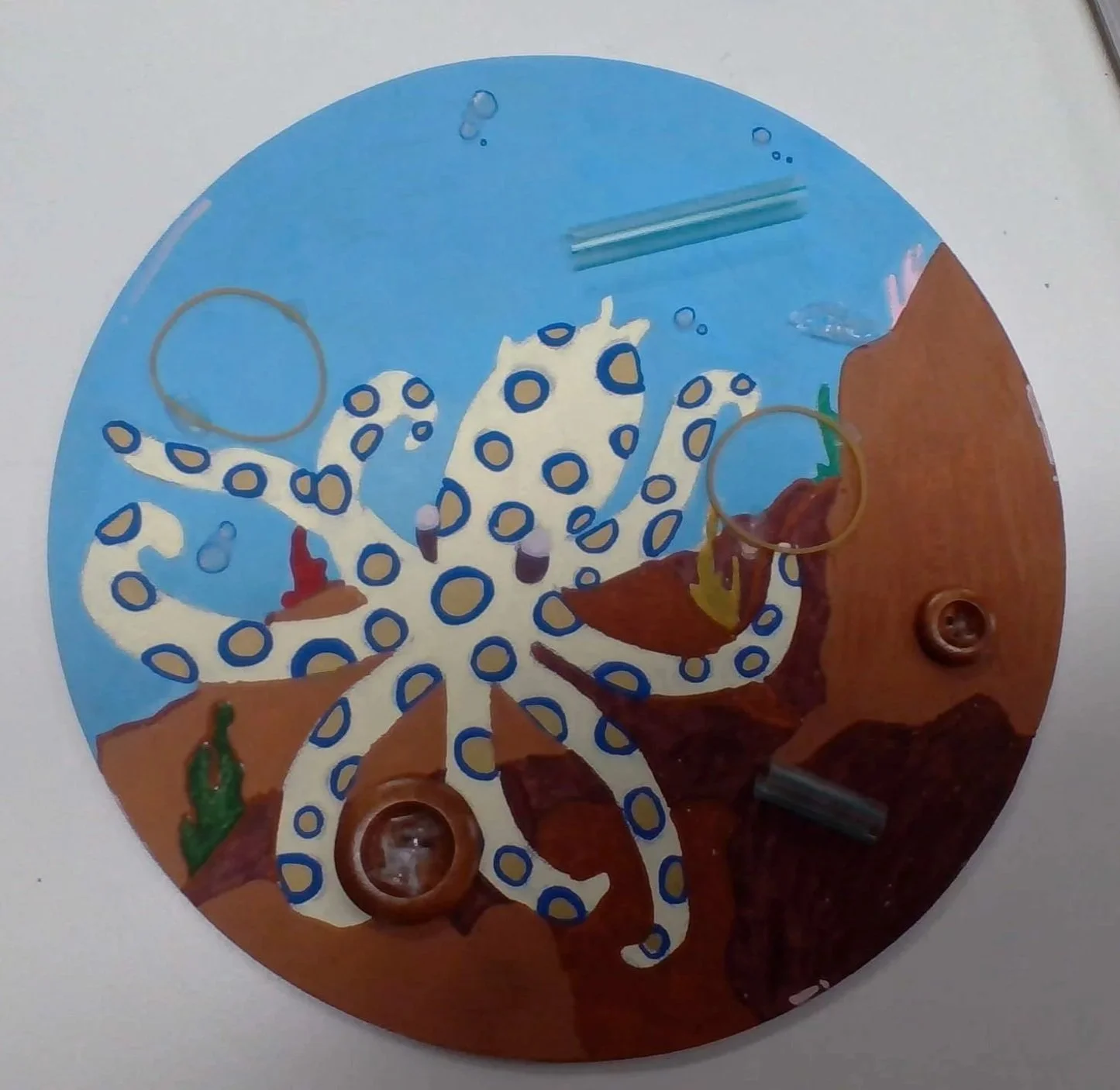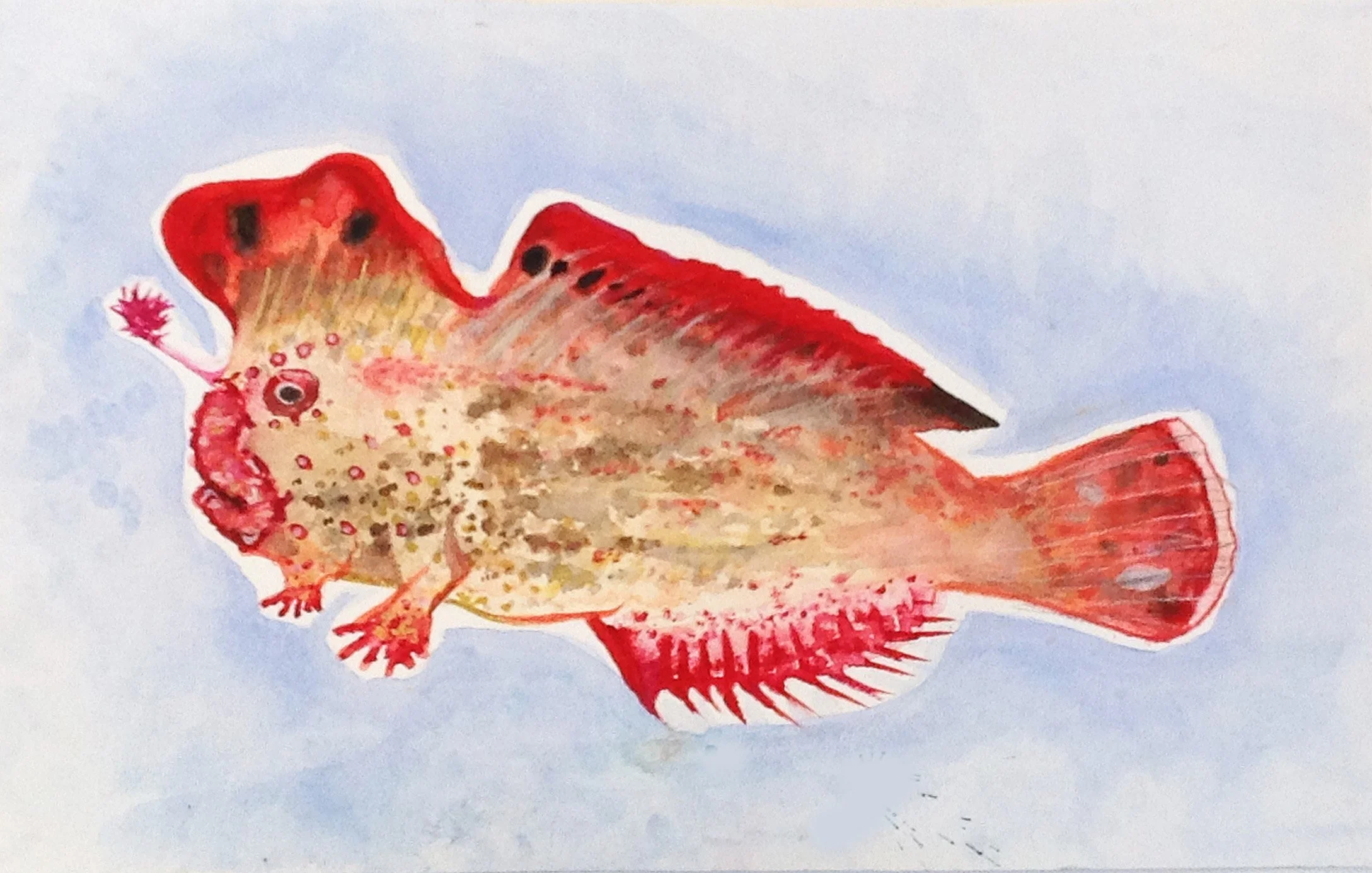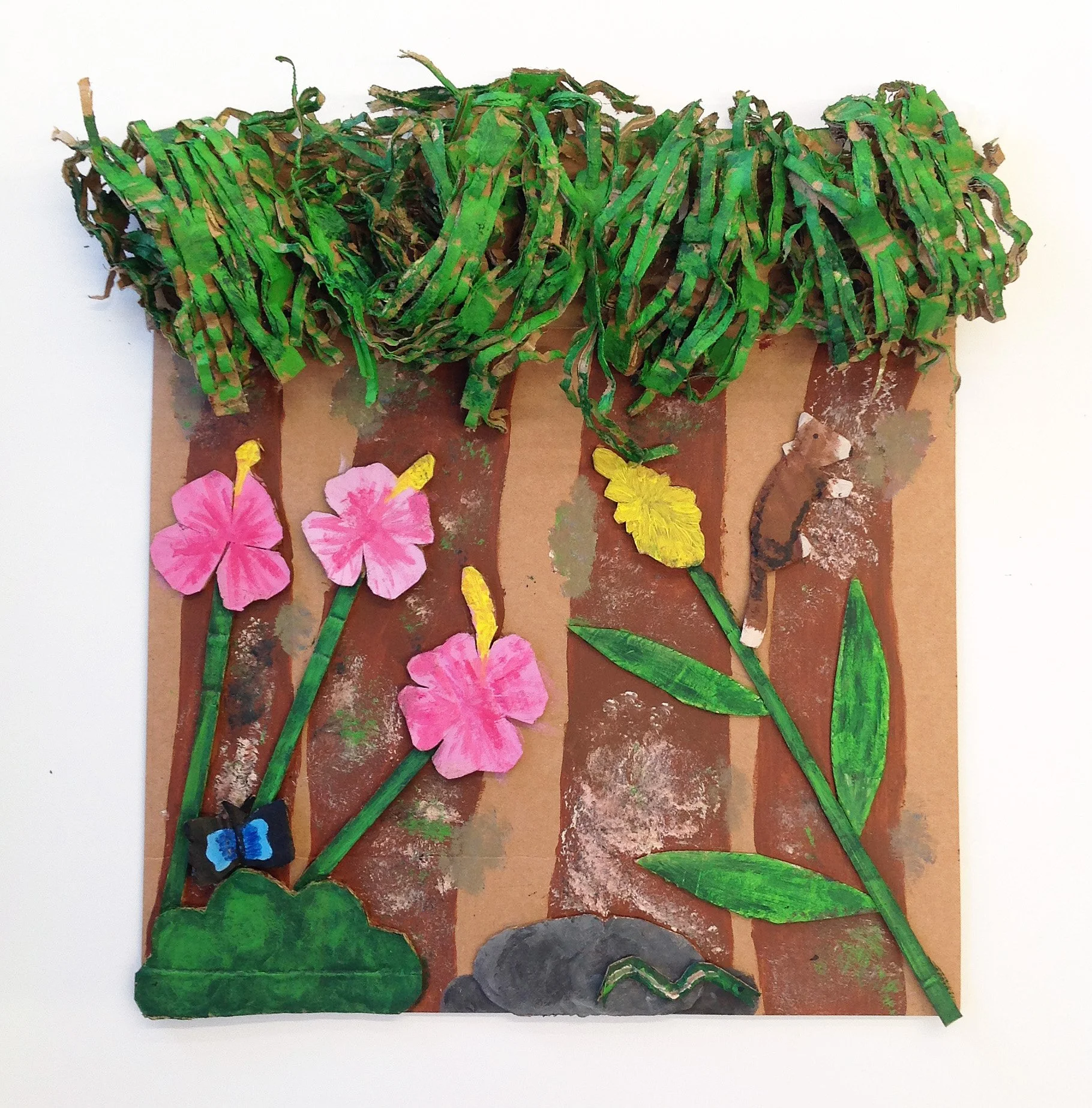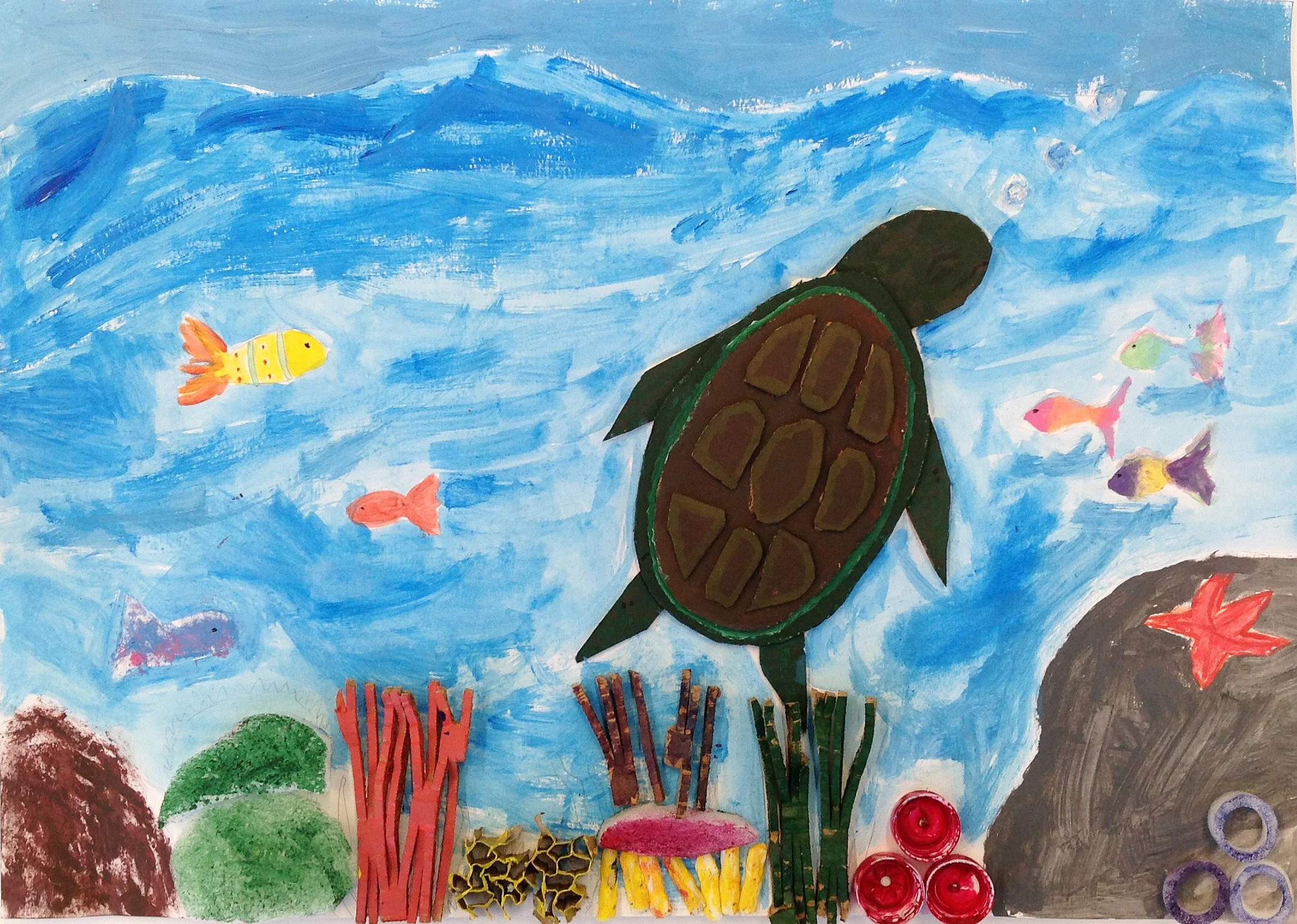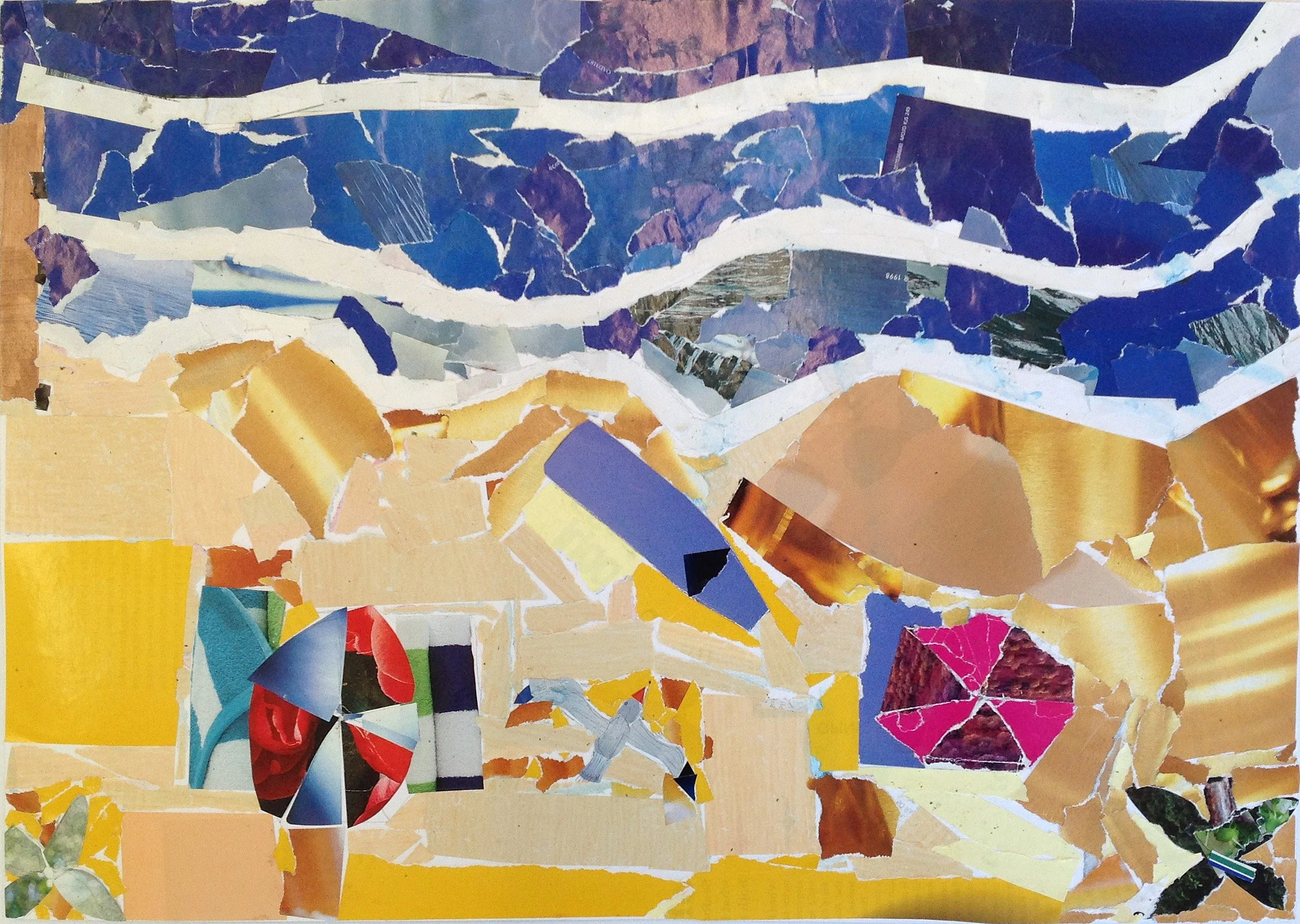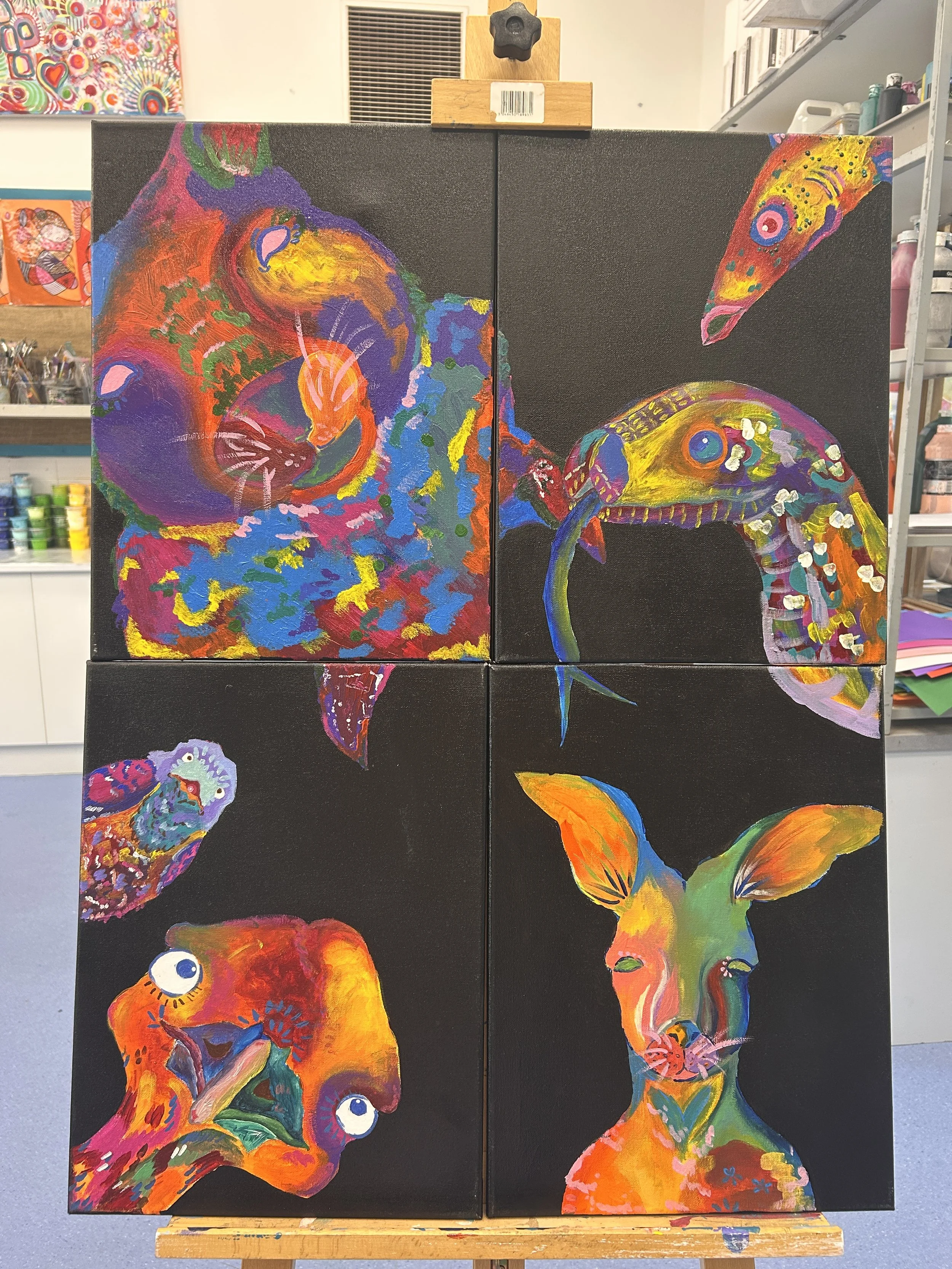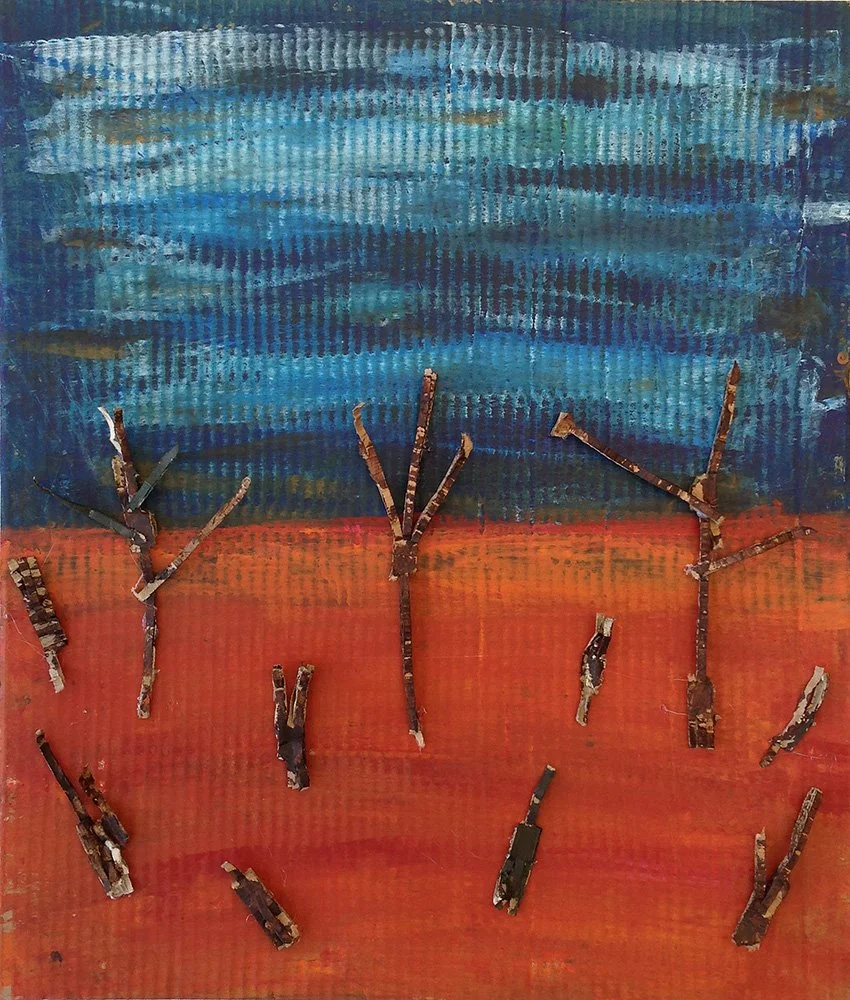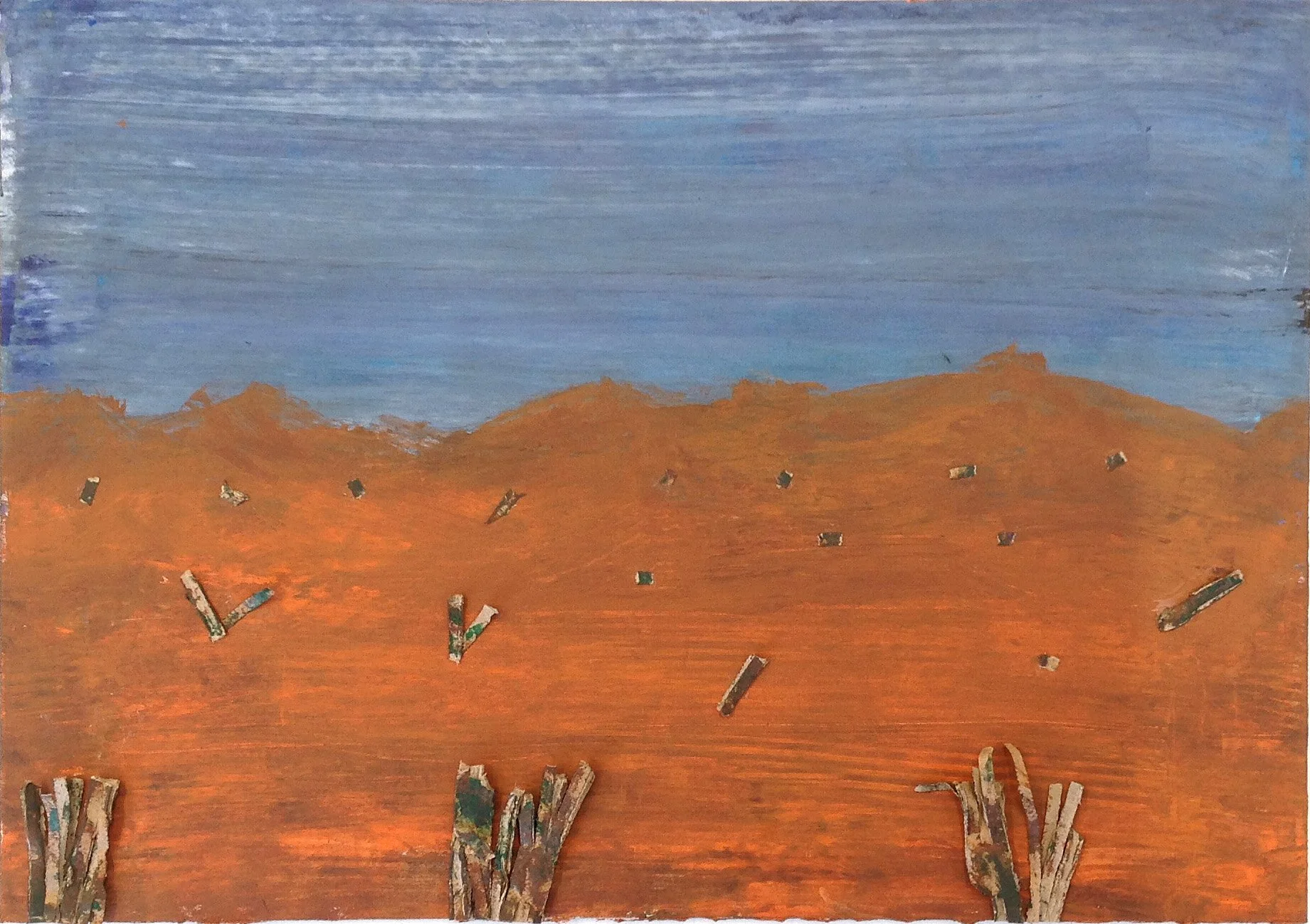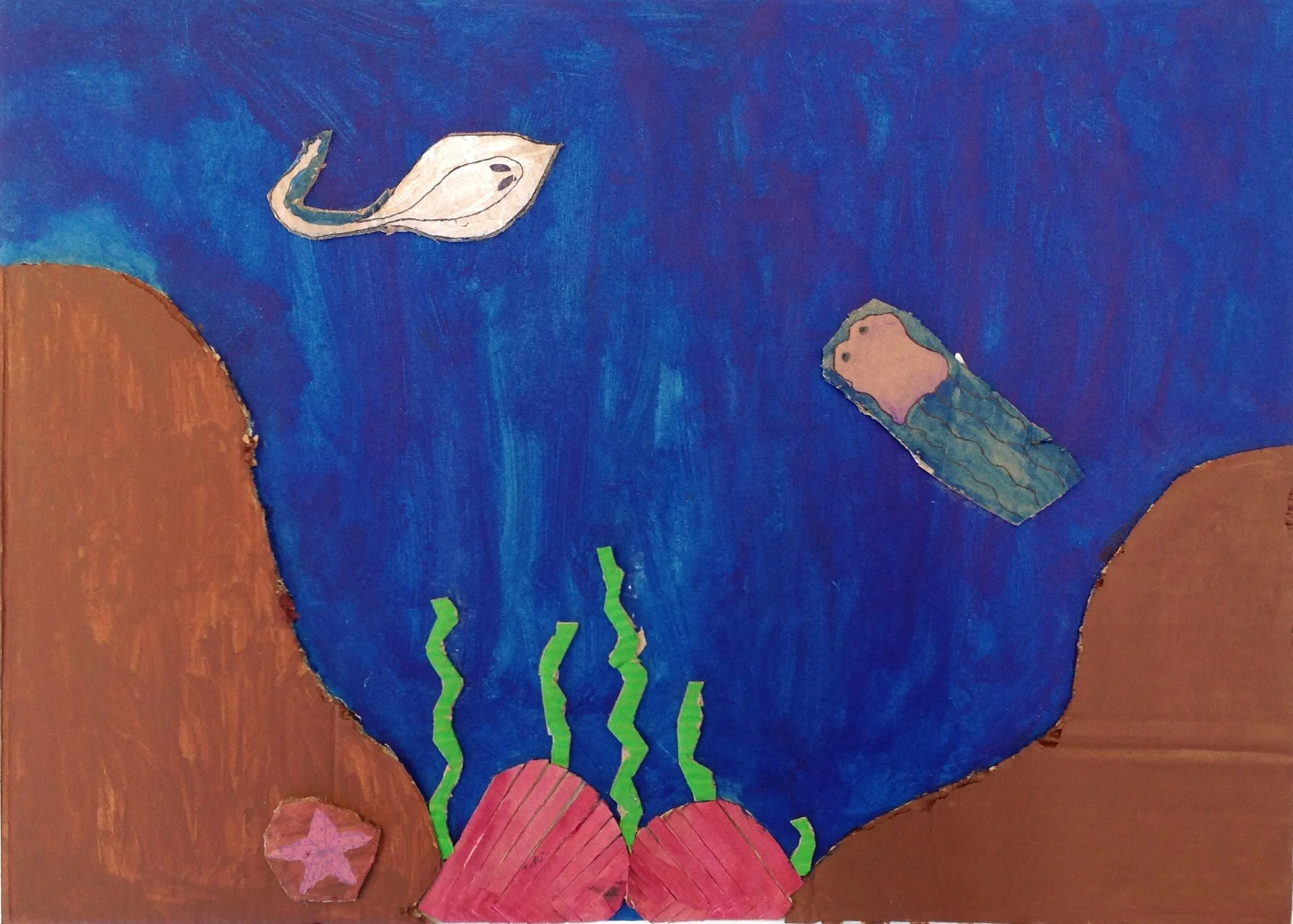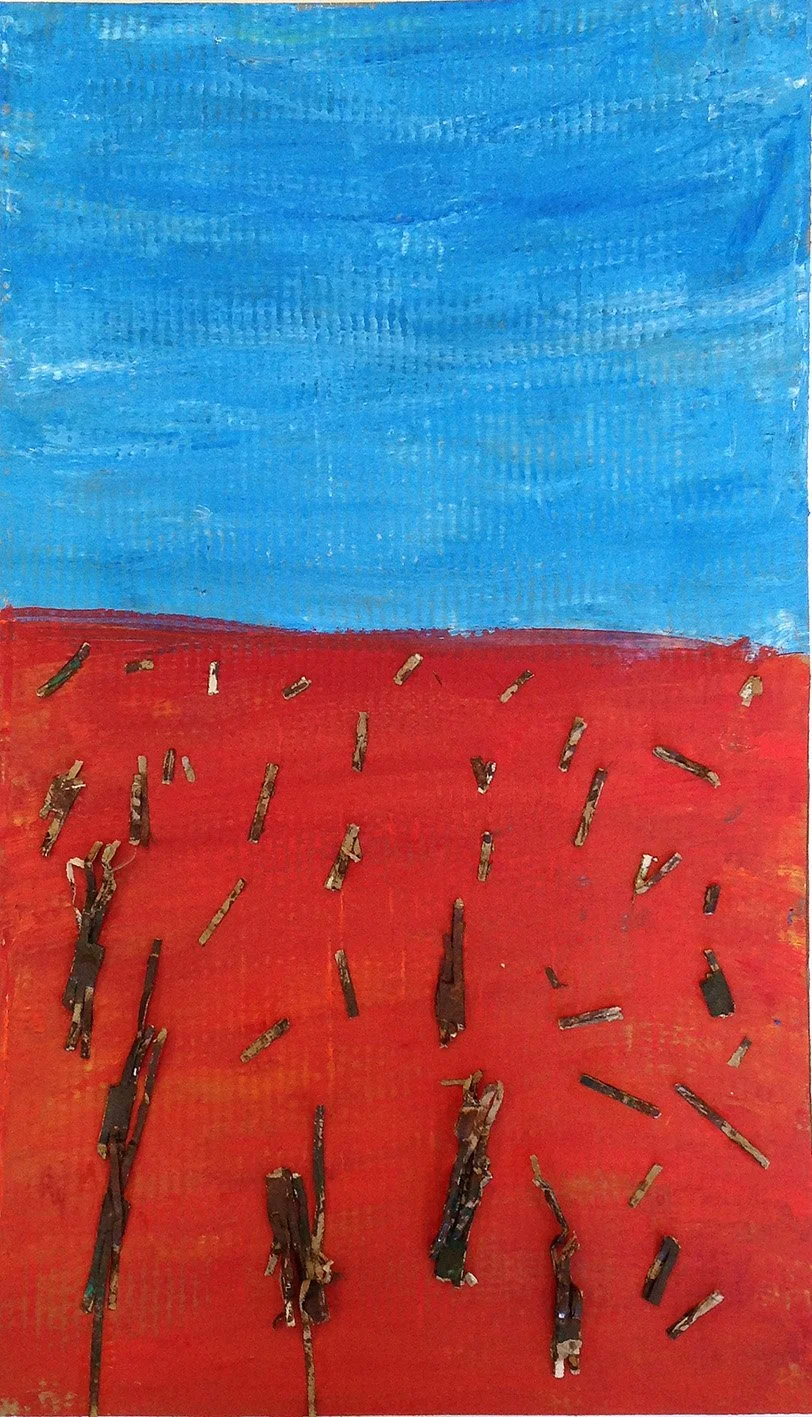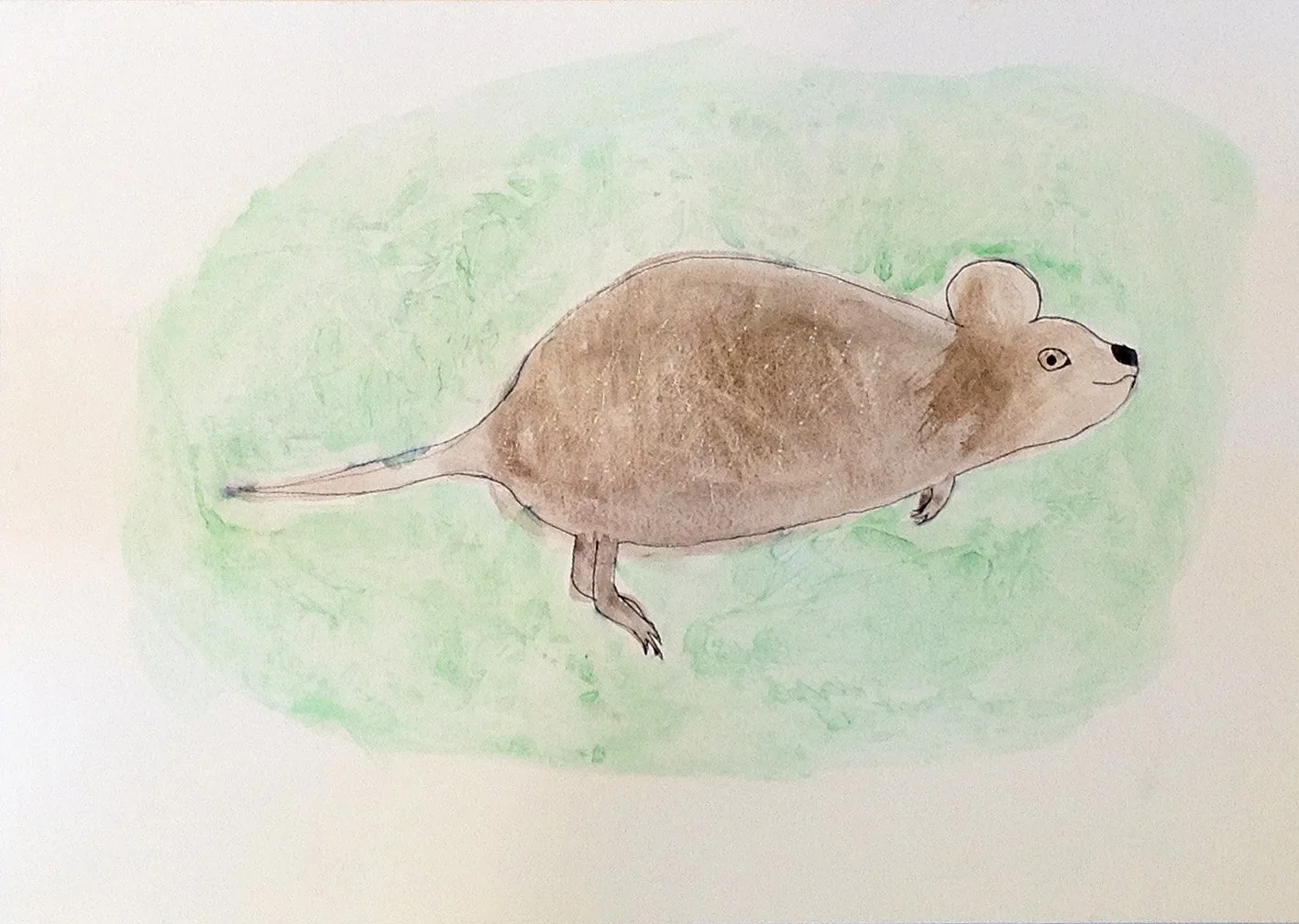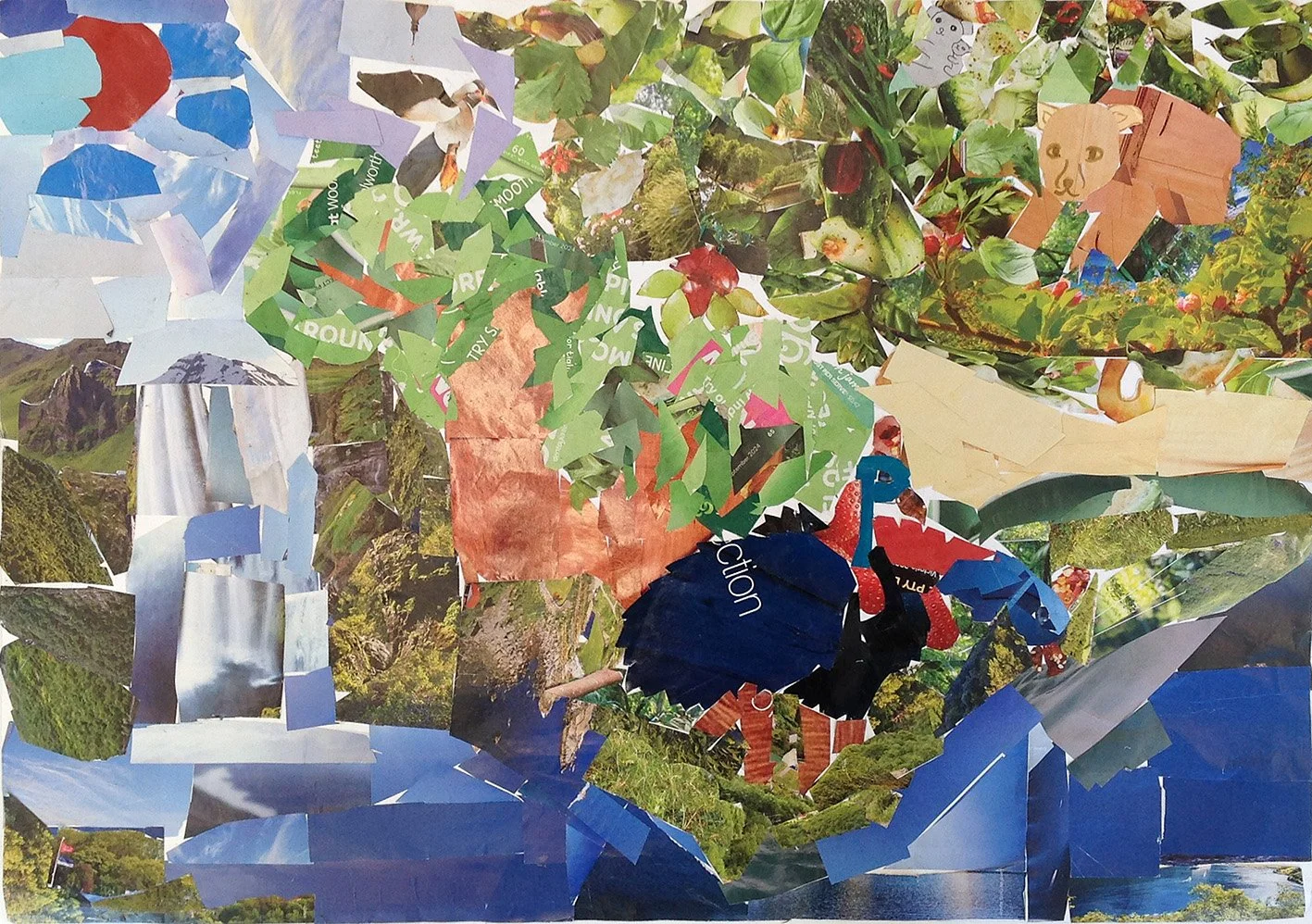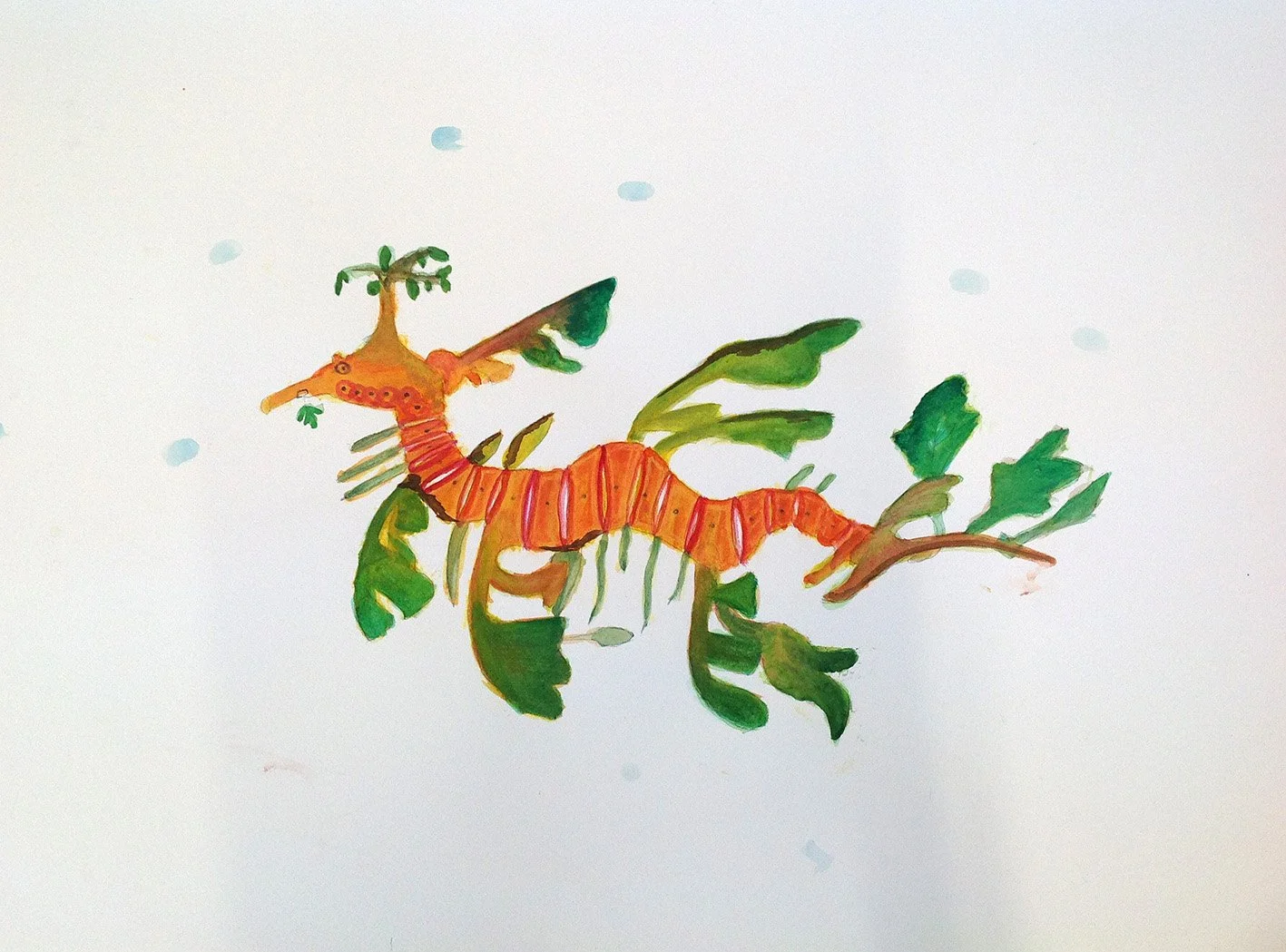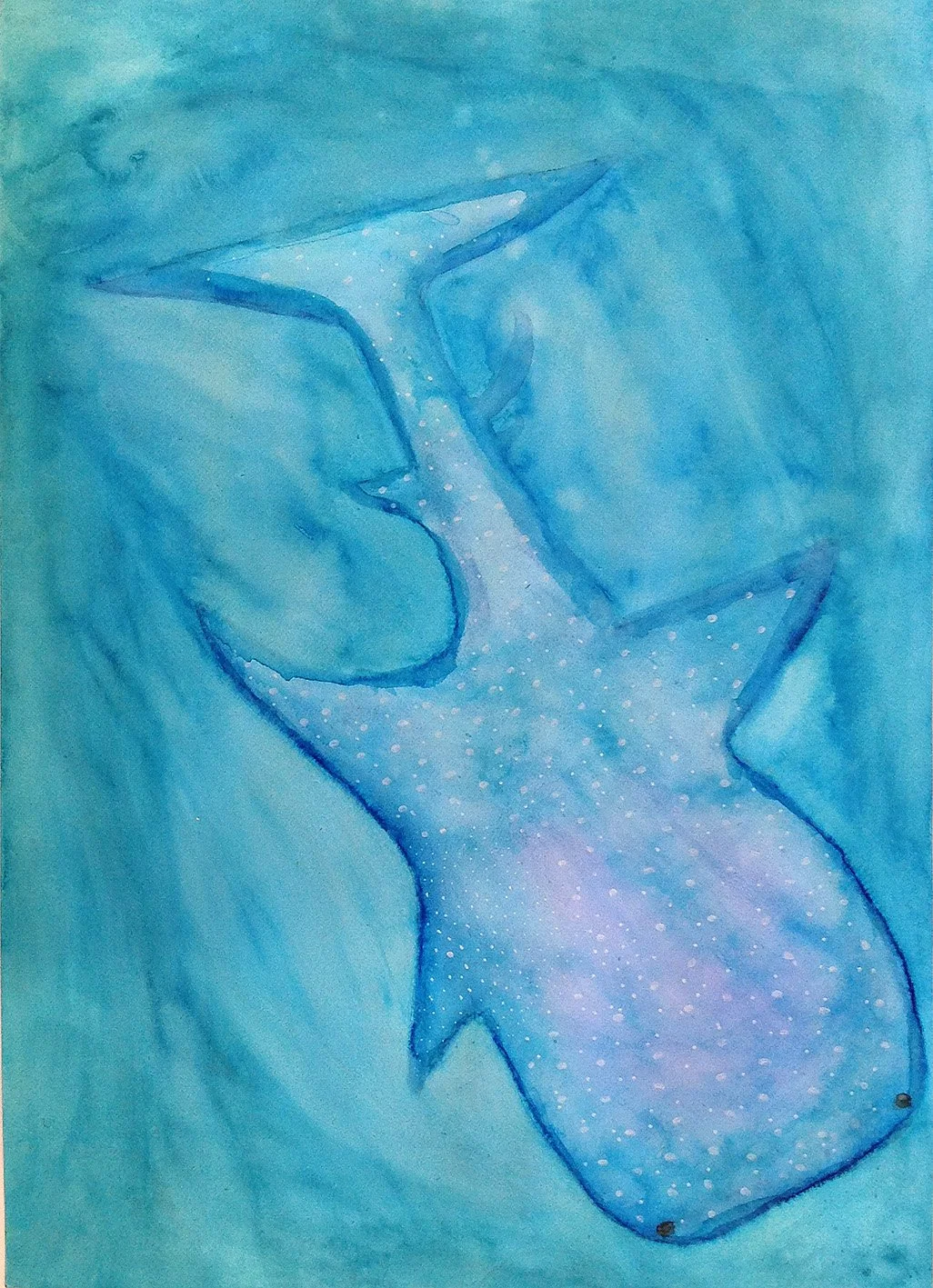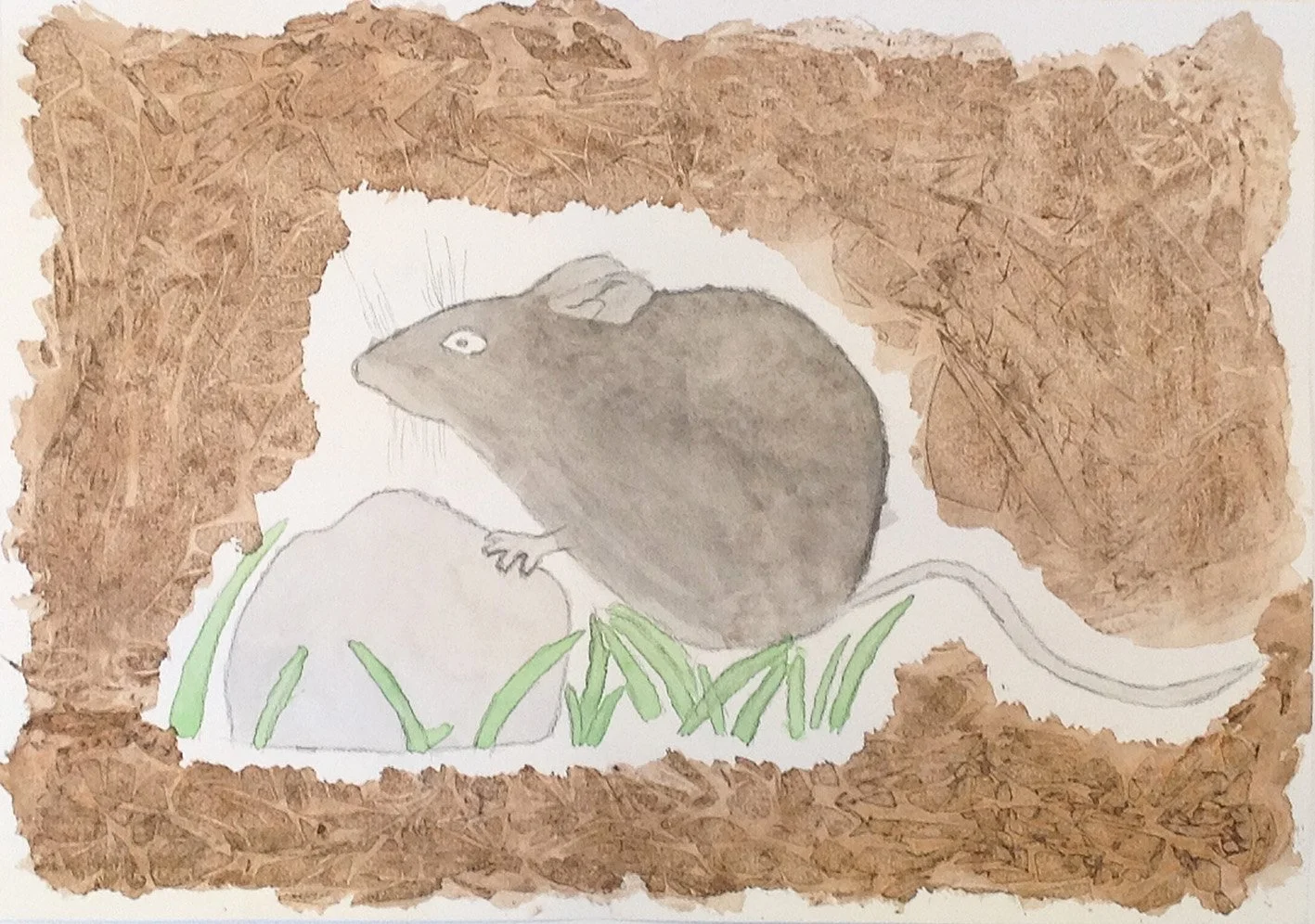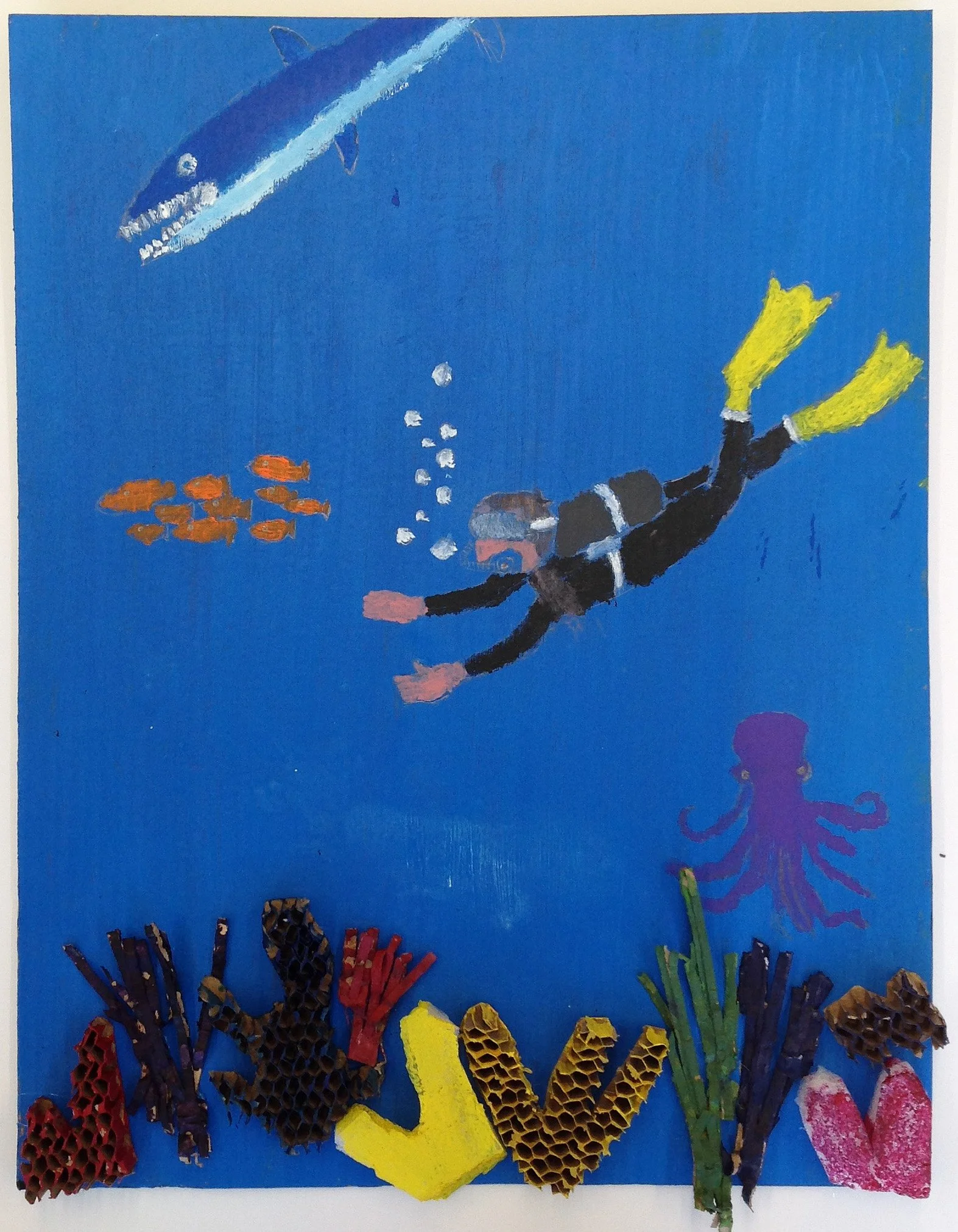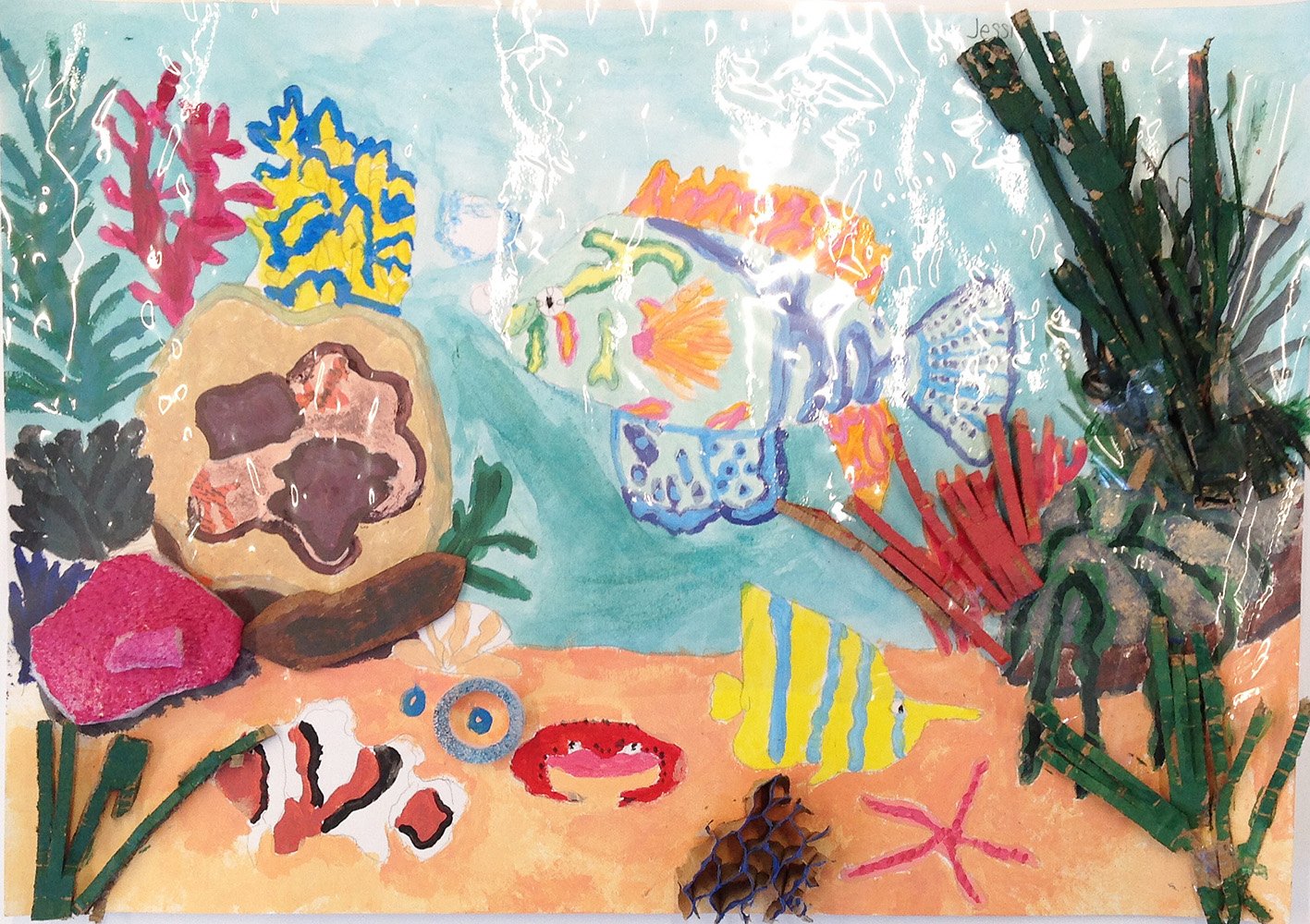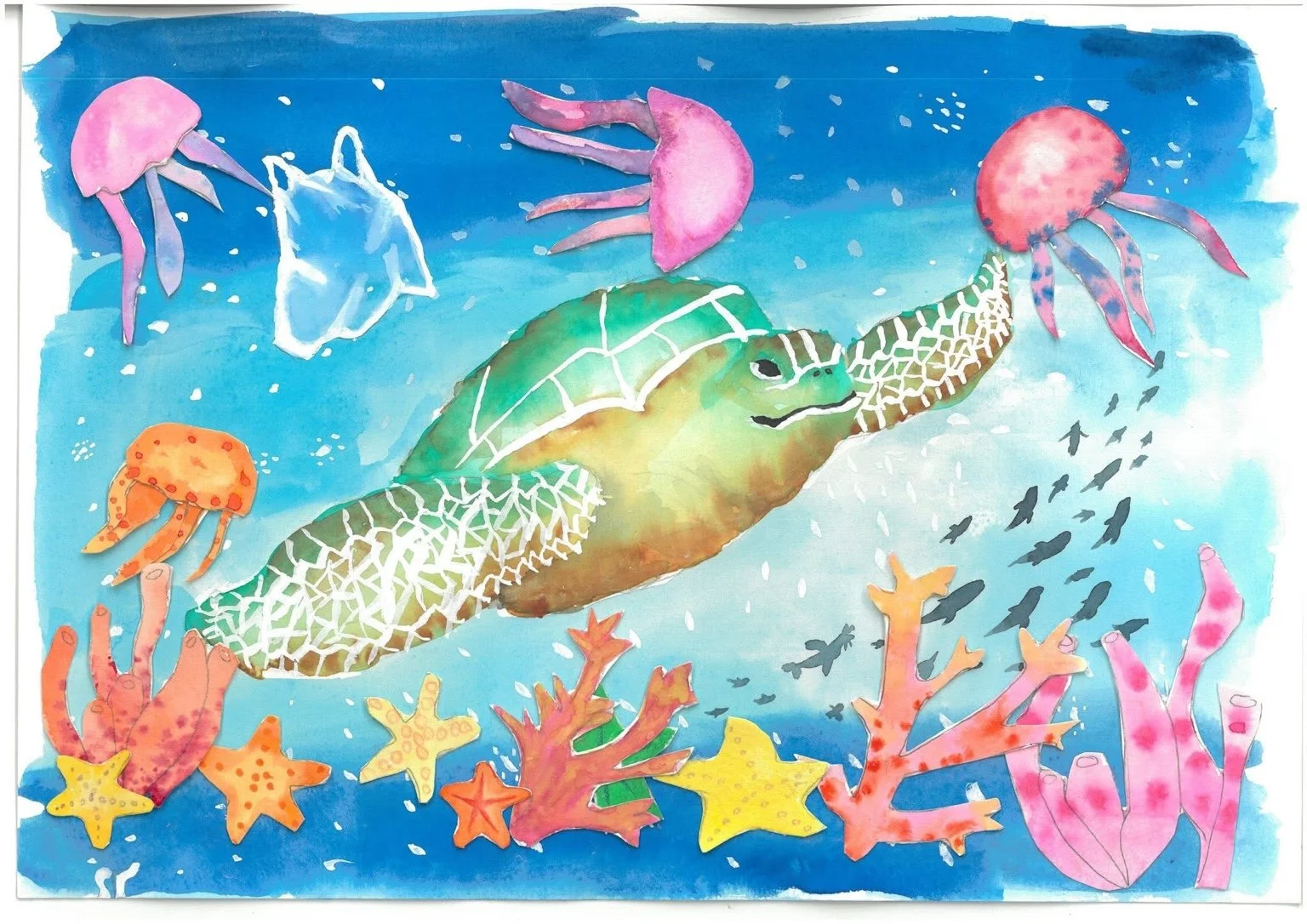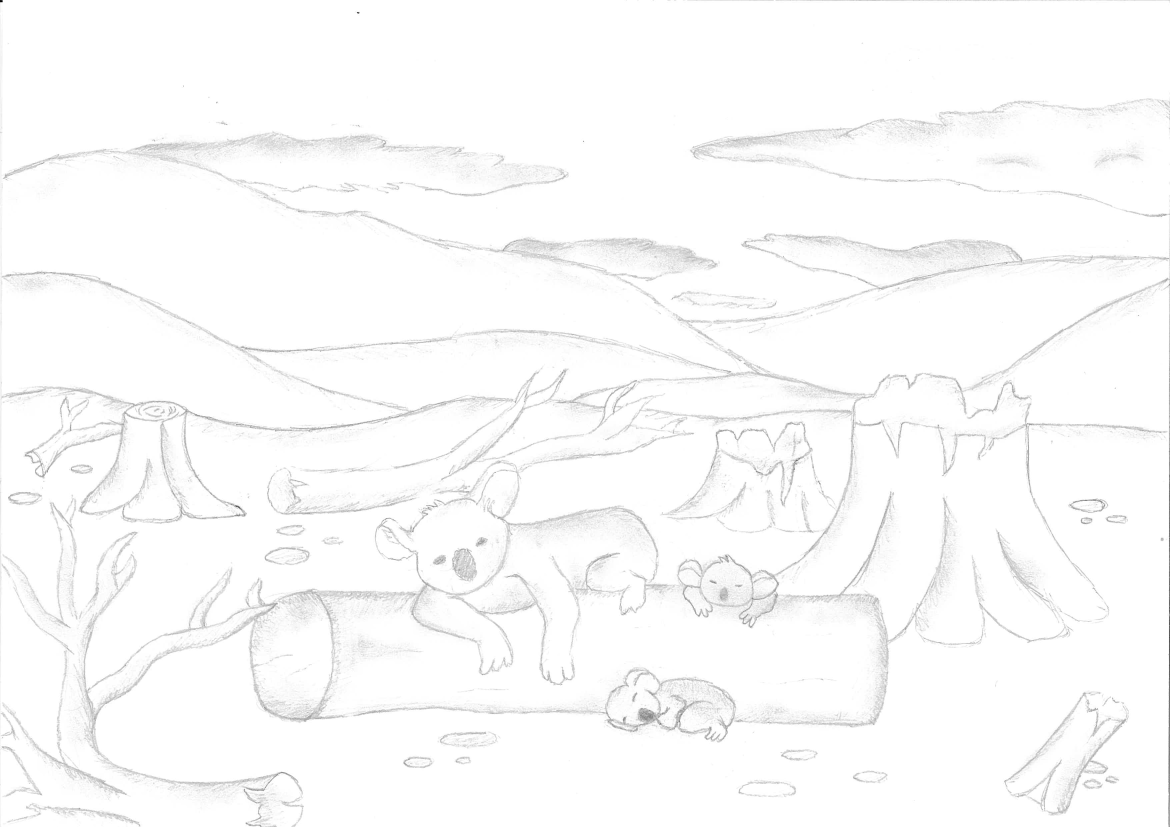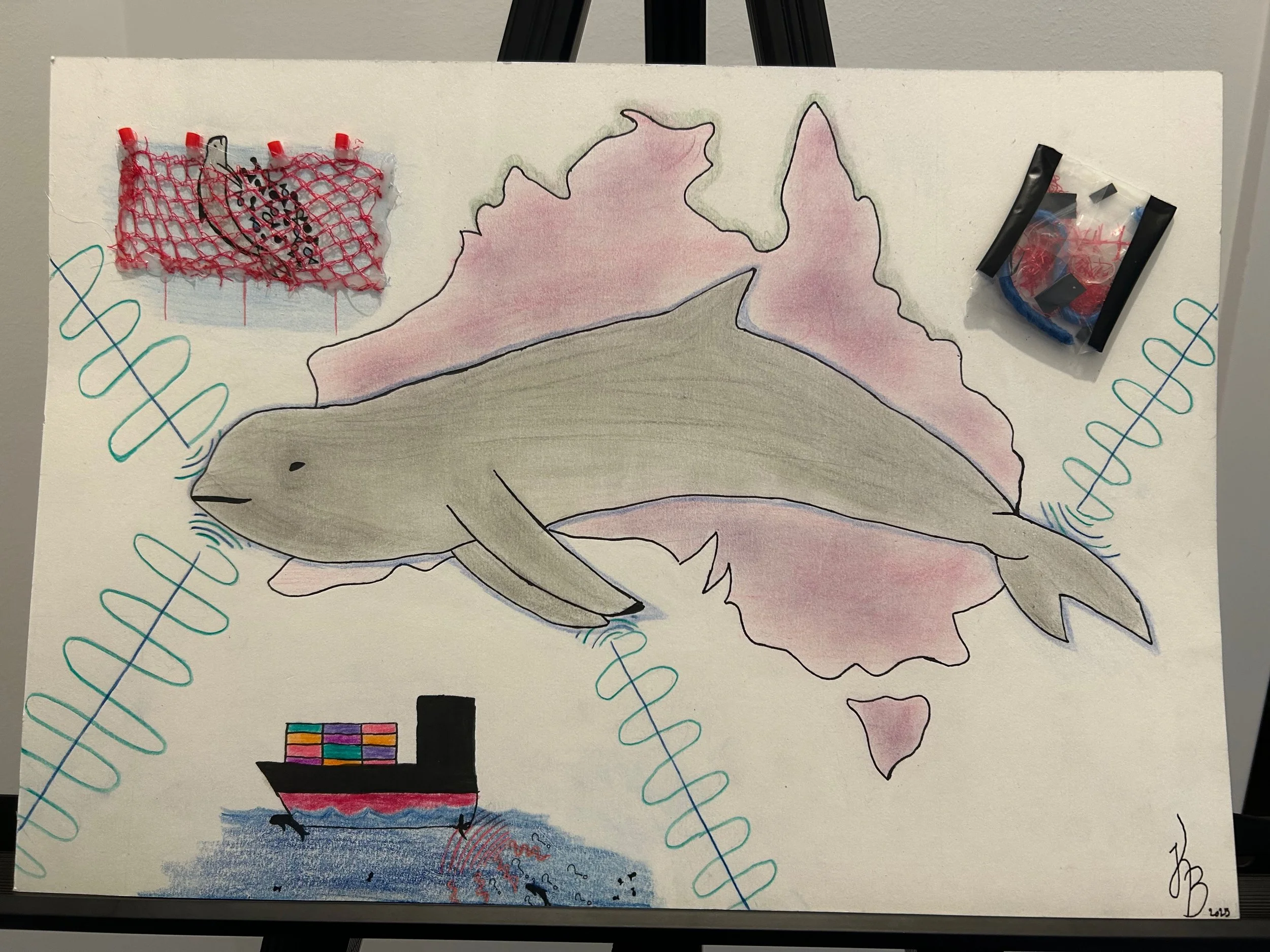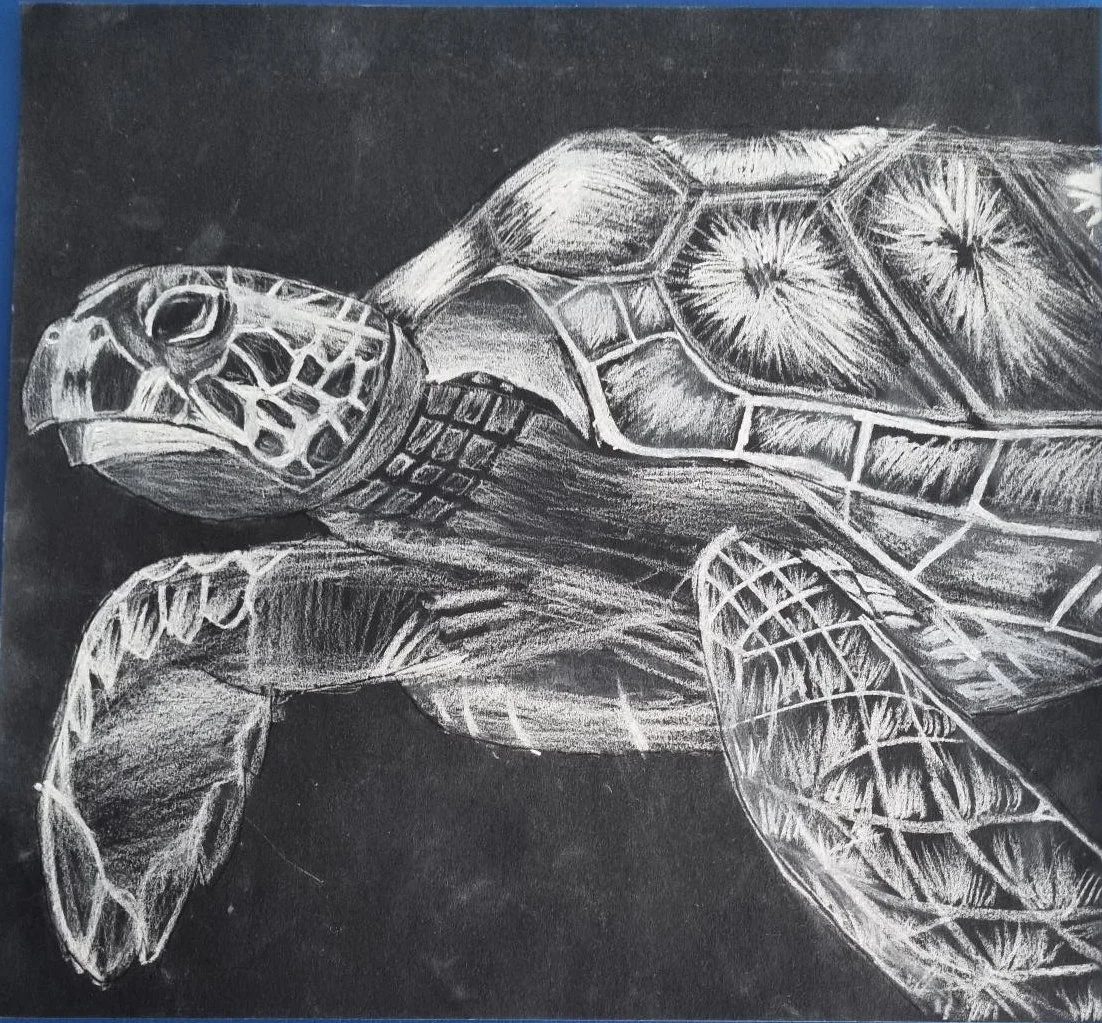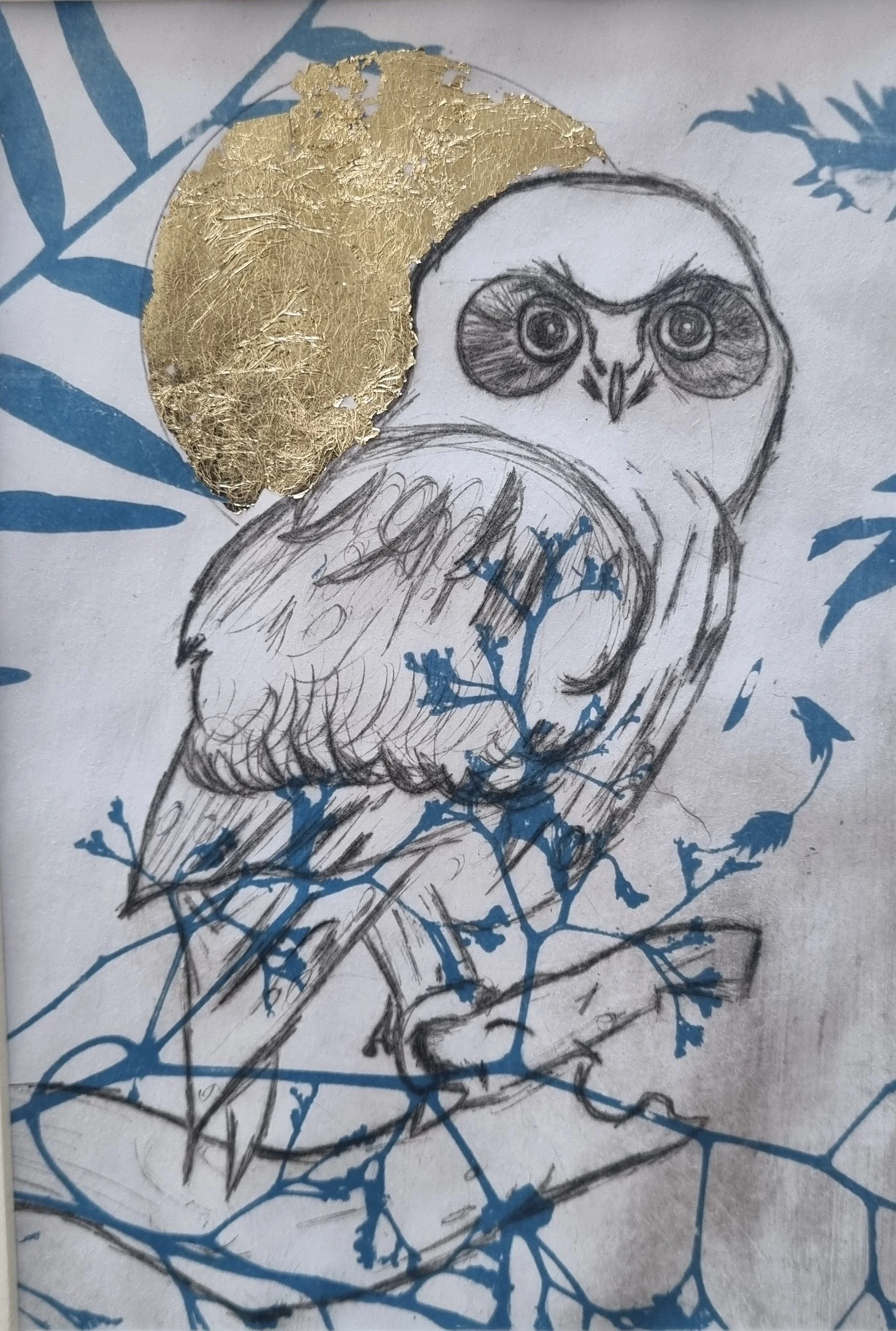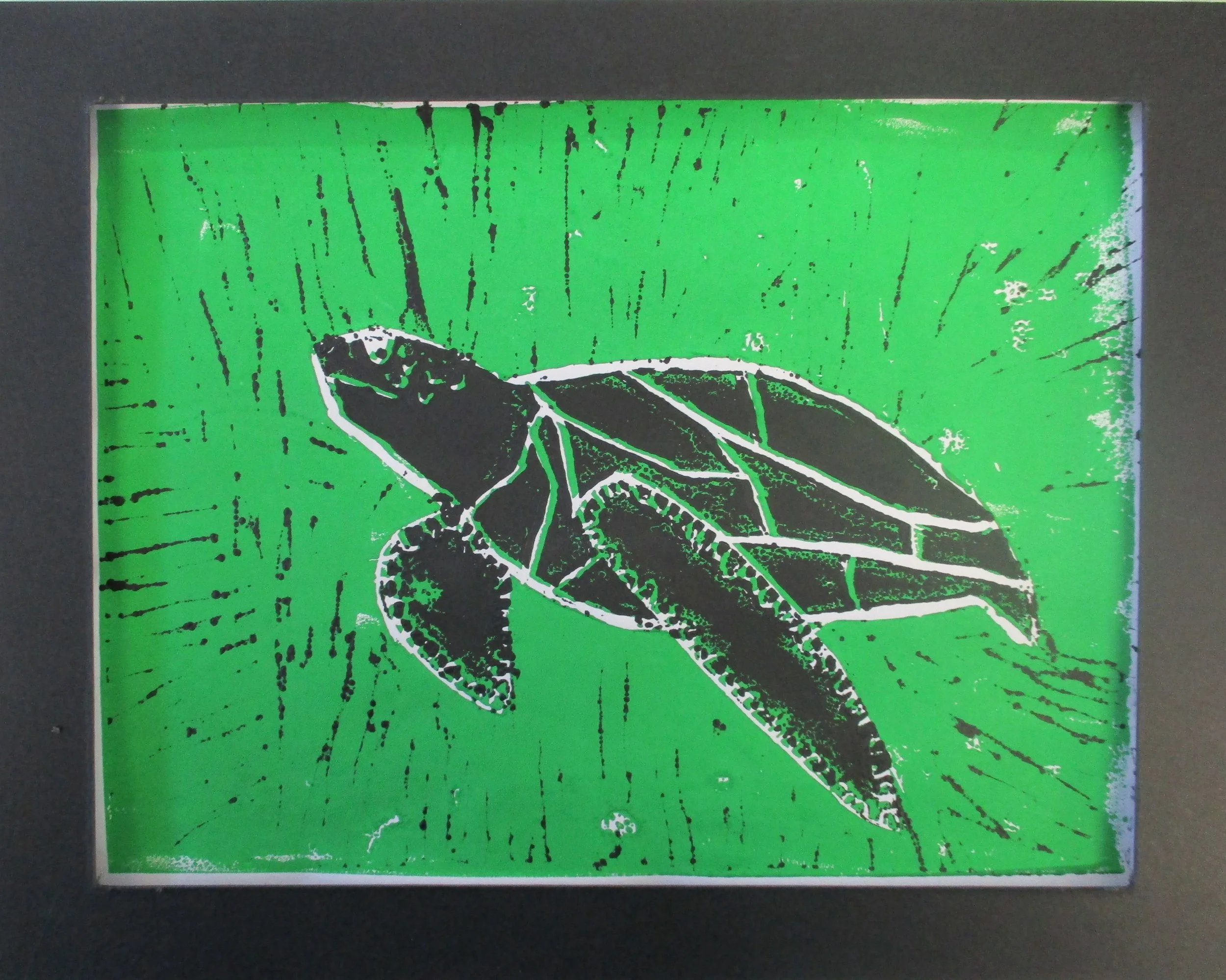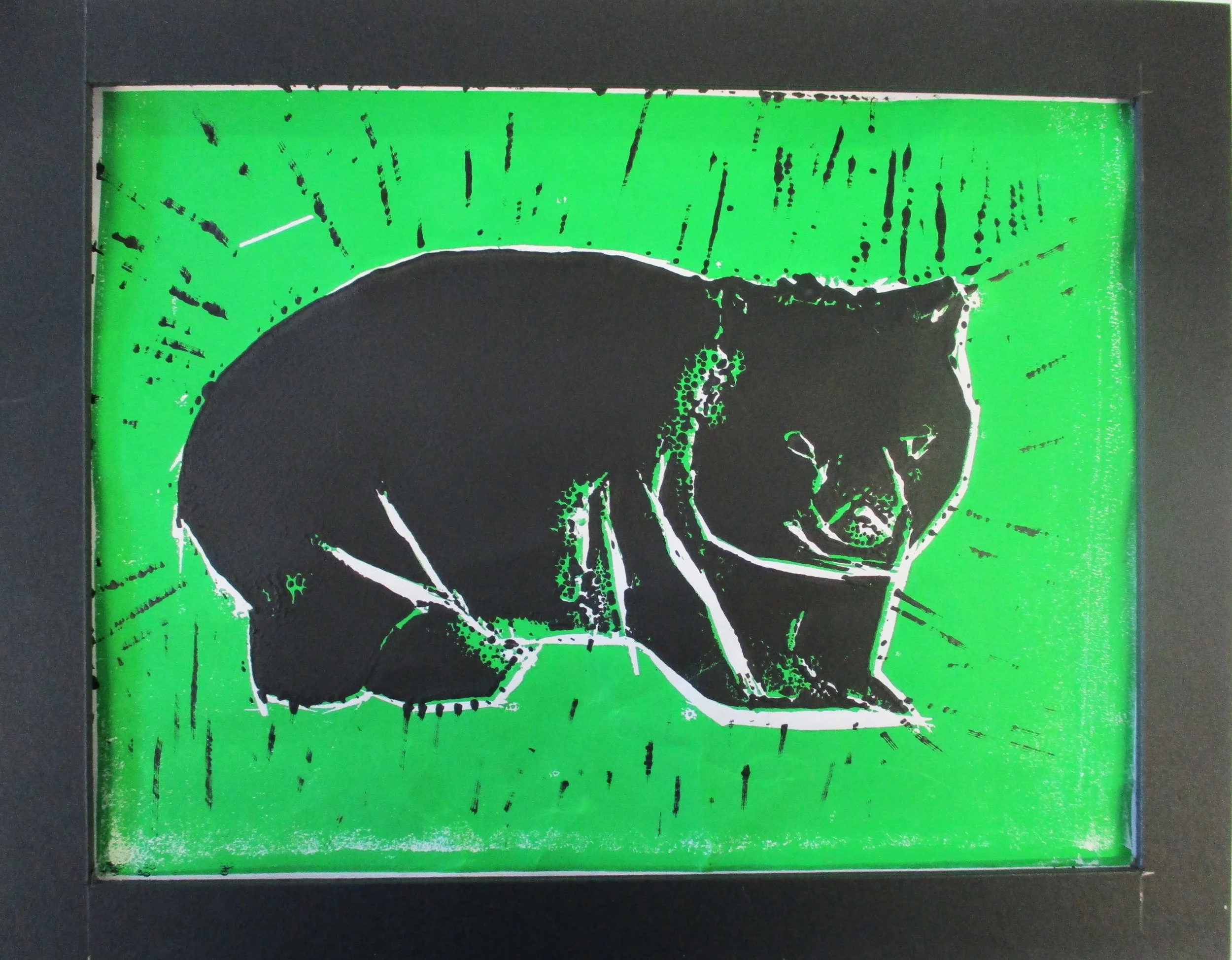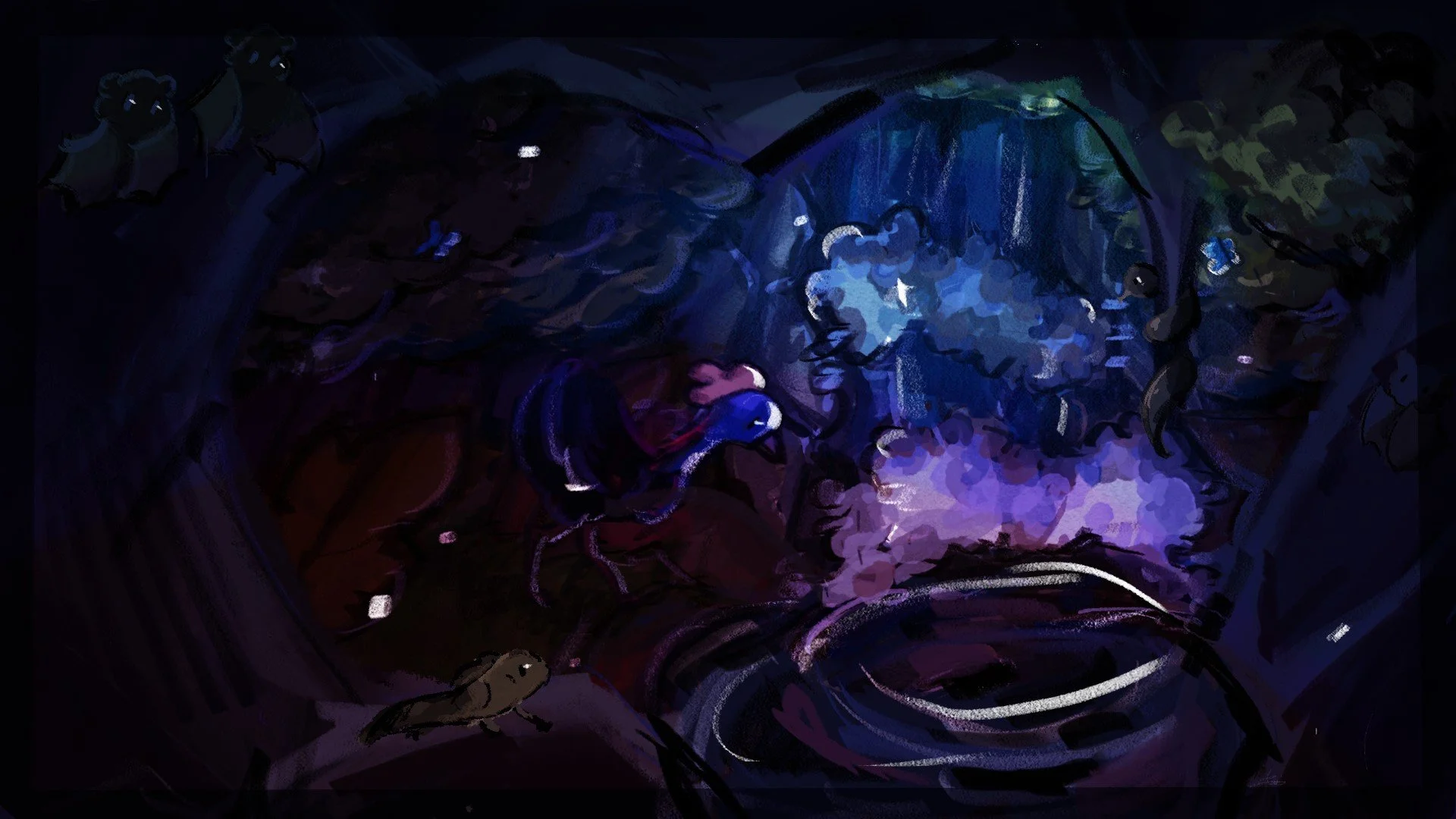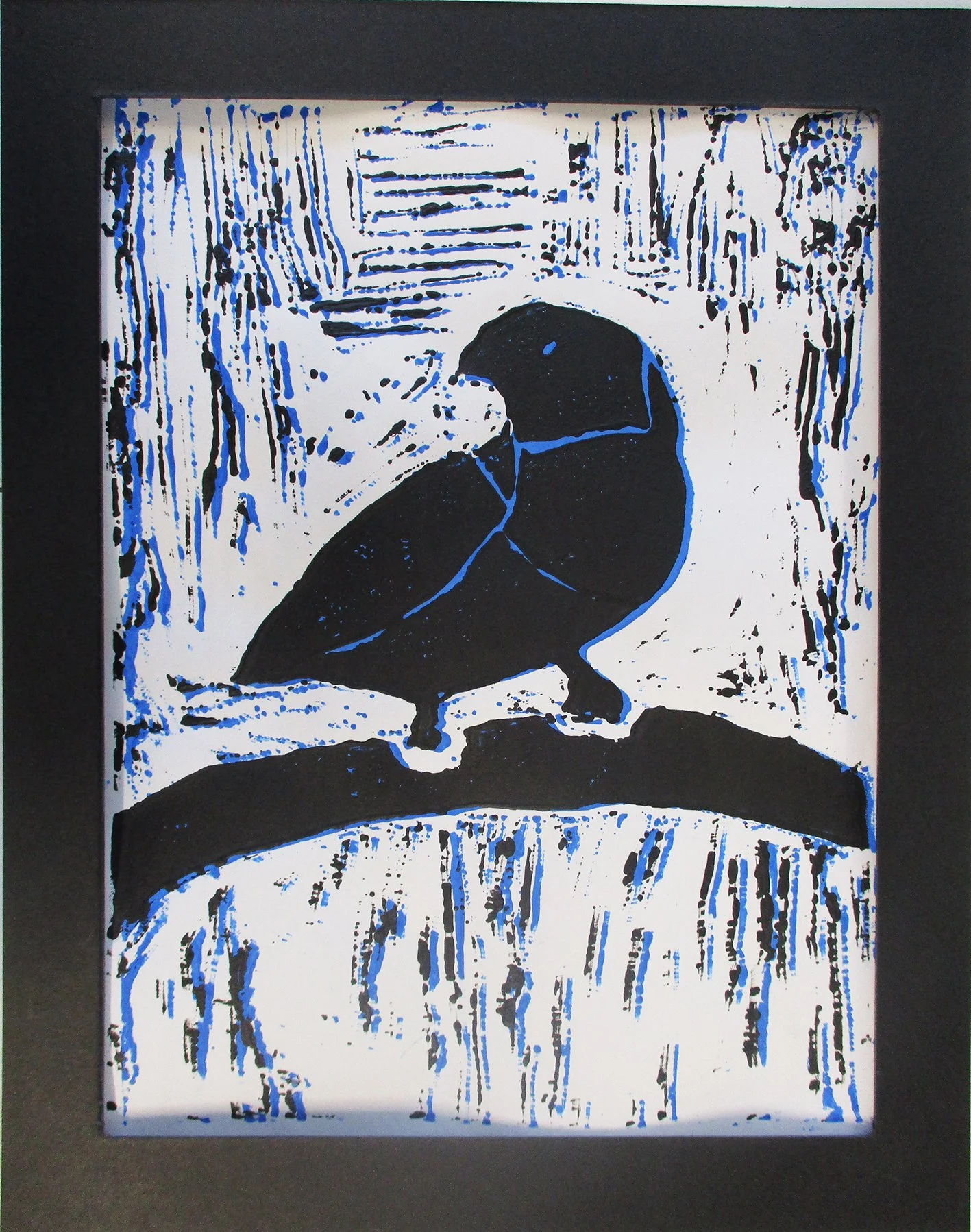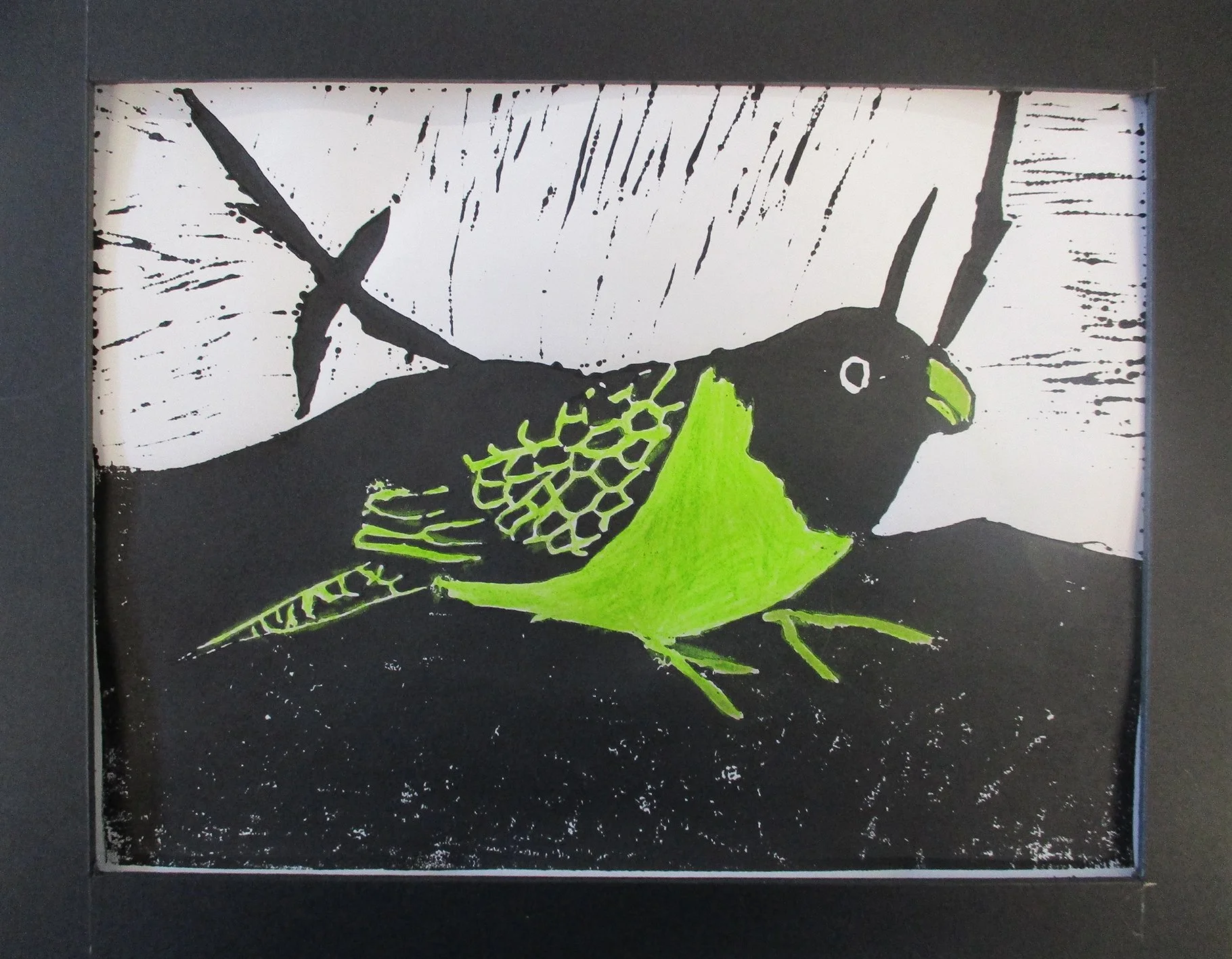Gallery.
Ruby Keam - Orange Bellied Parrot
1ST PRIZE WINNER | YEARS 7-8
The orange bellied parrot is critically endangered.
The parrot is at risk due to human development and loss of their habitat. In addition, they are also often hunted by predators such as cats. They often face threats from introduced birds. I tried to enhance the colours of the bird to create a beautiful object that champions the species and raises awareness of its existence and threats.
Ashton Lynch - The Dangling Black-Eared Flying Fox
2ND PRIZE WINNER | YEARS 7-8
I decided to create a lino print of the Black-Eared Flying Fox because it is a majestic and unique animal. I wanted to highlight the importance of recognising this endangered species to promote understanding about the importance of the Black-Eared Flying Fox in our ecosystem.
The Black-Eared Flying Fox is greatly endangered due to the deforestation of its habitat and constant hunting of the species. In addition to this, the setting up of traps and other wires that are known to consistently entangle them pose a threat. In the lino print artwork, I represented the Black-Eared Flying Fox in an authentic and natural pose, dangling upside-down from a branch. It aims to highlight the importance of these animals, posing them as a cute and cuddly one rather than something that should be hunted or harmed.
Andi belle O'Neil - Silencing giants
3RD PRIZE WINNER | YEARS 7-8
Whales are going silent due sonar disruption in their environments
My are raises the issue of humans over use of sonars in the ocean and the whales are falling silent because of this and it has a bad impact on their lives.
Kael Coleman - Sea turtle
3RD PRIZE WINNER | YEARS 9-10
I chose to represent a sea turtle because they are endangered and often affected by pollution. For our art project we had to use recycled materials and I used cardboard to sculpt the turtle instead of adding it to the dump.
We sometimes see sea turtles on our local beaches, and if the algae bloom reaches Ceduna, it could harm their health and the ocean environment they depend on. My artwork shows how special and unique sea turtles are and how pollution can hurt them. I wanted people to see why it’s important to look after our beaches and ocean so the turtles that visit Ceduna can stay safe and healthy.
Mae Irvine - Mountain Pygmy Possum
1ST PRIZE WINNER | YEARS 9-10
I chose to represent these unique Australian species in hope to draw attention to the endangerment they face.
There are fewer than 2,000 mountain pygmy possums left in the wilderness of Australia. Climate change has caused the Bogong moth, which is the possums main food source, to become endangered. This, as well as the introduction of foxes and feral cats has caused the mountain pygmy possum to become critically endangered. The Gouldian Finch and Blue–Tailed skink are also shown on my vessel, both of which are endangered due to climate change and introduced species. The Gouldian Finch is also targeted by the illegal pet trade. I have included features of these animals’ habitat and food, such as the bogong moth.
My vessel brings attention to these creatures that aren’t given enough publicity and recognition. I hope that my artwork starts discussion and educates people about these less-well known animals.
Dallas Zalme - Keith the Scorpion
2ND PRIZE WINNER | YEARS 9-10
I created this to represent scorpions being poached from the wild.
My name is Dallas and I decided to create Keith the scorpion. Keith was created to represent wildlife poachers taking creatures, like Keith, from their natural habitats in Australia. I hope my piece spreads awareness on how serious this really is! Thank you for your attention.
Maria Gatus - Protect the patterns of our reef
3RD PRIZE WINNER | YEARS 11-12
Wanted to show what a thriving reef environment looks like while still displaying the reality of a damaged reef to foreshadow its future.
The Great Barrier Reef is progressively dying and will continue to do so due to negative human interaction and neglect towards the care of the habitat. I wanted to promote anti-pollution, illegal fishing and coral harvesting messages as there is also the often thought of “sea-life” or “shark-infested waters” when in reality it’s humans invading and/or damaging the habitat, out of carelessness or exploit. Therefore I wanted to counter that statement by showcasing the habitat the way it should be, away and safe from damaging engagement.
Jaylee Rosenzweig - Fading
2ND PRIZE WINNER | YEARS 11-12
I wish to bring attention to the impacts of pollution on marine life.
My artwork depicts the effect of pollution and fossil fuels. The fading green sea turtle indicates the inevitable consequences if nothing is done to solve the issue.
Grace O'Neil - Cute enough for conservation
1ST PRIZE WINNER | YEARS 11-12
The purpose of my painting is to bring attention to the lesser appreciated creatures that don’t tend to appeal to the public, everyone wants to protect the beautiful butterflies and cute elephants but not many see the purpose in protecting the creepy crawlies that play vital roles in the maintenance of their environments.
Pesticides, invasive species and loss of habitat due to construction threaten the micro ecosystems of the smaller less appreciated native insects, my artwork draws attention to the bias towards more stereotypically cute bugs rather than those that are at risk due to their less aesthetic appearances.
Alexander Jain - Sanctuary
HIGHLY COMMENDED PRIZE WINNER
My artwork shows an intact coral reef ecosystem featuring the majestic green sea turtle. This fragile environment is currently endangered on account of the degradation caused by human intervention.
Illegal fishing, poaching of turtle eggs and pollution from various sources affect the green sea turtle represented in my artwork, while the coral reefs are damaged by blast fishing, coral harvesting and ornamental fish trade.
My artwork helps enhance awareness of the beauty of this environment, the co-existence of flora and fauna and the need for its conservation.
Clark Shi - Greater Glider
HIGHLY COMMENDED PRIZE WINNER
I chose to represent the Greater Glider because it is a beautiful and rare Australian animal that many people don’t know about. I want to show how special it is and why it should be protected.
The Greater Glider is affected by wildlife crimes such as deforestation and land clearing, which destroy its forest home. My artwork helps raise awareness by showing the beauty of this animal and reminding people to care for the forests it lives in.
Aidrian Banaag - Havenwood
HIGHLY COMMENDED PRIZE WINNER
I decided to depict the forest ecosystem because it is the Azure Kingfisher's home and the habitat of a multitude of other creatures that rely on healthy gum trees and watercourses to exist.
The biggest wildlife crimes threatening this environment are illegal logging and land clearing, which wipe out the trees and rivers the Azure Kingfisher requires for reproduction and food. My artwork brings attention to the issue by illustrating a secure, guarded forest where rivers, gum trees, and wildlife can thrive. By incorporating my painting of the forest and magazine cutouts of nature, I aimed to depict how thick and teeming with life the habitat would be if it were rescued from destruction.
Taleea Clappis - Spencer Gulf Snapper Protection
HIGHLY COMMENDED PRIZE WINNER
I chose to represent the snapper of the Spencer Gulf as local Whyalla businesses were affected with this environmental issue. My family’s business, "Whyalla Fishing Charters", was severely impacted by the Snapper Ban which caused him to shut his business down.
The snapper ban was connected with the annual Whyalla Snapper Fishing Competition. Numerous amounts of snapper were being caught amongst The Spencer Gulf - having to be thrown back when a bigger one was caught - meaning throwing back the dead fish just to have a chance to win.
Kiara Shepherd - Eastern Quoll
HIGHLY COMMENDED PRIZE WINNER
Eastern quolls are distinct and beautiful animals. I wanted to highlight the dramatic pattern and look of the animal.
Quolls are impacted by many human behaviors such as poisoning, road collisions but most significantly the introduction of feral animals such as cats and foxes. Climate change is also having a damaging effect on them.
Mira-Jane Van Kerken - Schrodinger's Wallaby
HIGHLY COMMENDED PRIZE WINNER
I chose to represent this animal because of how common their deaths are.
The artwork is from the perspective of a driver and depicts a young wallaby standing on a road, half alive and half dead. I chose to represent this due to how common their deaths are, shown by the other wallabies lying on the side of the road beside it. The hazy glow around the wallaby shows the driver’s distraction and makes it clear to the viewer that it’s their choice if it lives or dies.
Reemas Ahmedi - What Could Be
HIGHLY COMMENDED PRIZE WINNER
The Golden-Shouldered Parrot is actually a type of bird that’s entwined with aboriginal culture, specifically the Olkola people, which originally drew me in. The beautiful orange underbelly had captured me further, and how they assist in seed dispersal sealed the deal.
Psephotellus Chrysopterygius otherwise known as the Golden-Shouldered Parrot is a critically endangered species of bird, caused by mainly illegal pet trade but also accredited to other factors such as habitat loss, predation of introduced animals like feral cats and goannas, climate change, and damaged nesting habitat being destroyed by cattle and pigs while also overgrazing their grounds. By displaying the beauty of the animal in its natural habitat, it’s possible to rally people to love the bird and want to protect it so it can actually live out the life it should be living.
Ava Orlowski - Paper Currents
HIGHLY COMMENDED PRIZE WINNER
Coral reefs are vibrant, fascinating ecosystems full of life, and I've always been enchanted by the almost otherworldly beauty they posses.
Wildlife crimes such as illegal fishing, coral poaching, and destructive practices like blast fishing or overharvesting affect coral reef habitats by destroying their delicate structures and endangering the species that depend on them. My artwork helps raise awareness by showing the reef’s vibrant beauty and fragility, encouraging people to appreciate and protect these ecosystems rather than exploit them.
Cyra Marbas - Protect the Platypus
HIGHLY COMMENDED PRIZE WINNER
I was inspired by the knowledge I gained about the Platypus while I was on a school excursion. We learnt that they are threatened due to waste in the water which is an issue that concerns me.
Sadly, the beautiful and elegant Platypus is threatened by the loss of its habitat caused by polluted water and the clearing of land. I hope that this lino print artwork raises awareness about the impact that humans have on the environment and encourages people to consider the affect their actions have on endangered species, in particular, the Platypus.
Allison Bendicho - All That's left
I decided to choose this Australian animal in particular as it demonstrates clearly of the beautiful creatures we have here, such as the Black tail Cockatoo.
Due to habit destruction and deforestation. There aren't enough food or habitats for animals such as these birds. The painting shows the result of deforestation, as what's left is the bird on a tree branch and empty land. Not any other source of life in sight.
Gabriella Hallam - The deep blue sea
I chose the blue ring octopus because it is a deadly animal which is native to Australia, gold coast. This deadly animal is also an endangered animal although the harm it does to people.
Wildlife crimes that affect the species are littering, fishing, pollution.
Elisha Hubner - Burning Leadbeater Possum
I have chosen too do a Leadbeater possum as they get effected by the fires that happen every year in Australia and they at are risk as there homes can't find new homes.
One of the things that affect possums is the Fires that destroy the land and trees they live in.
Crystal Collins - Sea Life Pollution
I chose a sea lion because they are being endangered by multiple things not only pollution.
In my artwork it shows the wildlife crime of pollution that is in ocean and harming animals.
Violet Pitman - The Red Handfish
I chose the Red Handfish because it is one of the rarest fish in the world, and I wanted to raise awareness about its beauty and the urgent need to protect its fragile habitat.
The Red Handfish is threatened by habitat destruction from coastal development and pollution, as well as the risk of illegal collection for the aquarium trade. My artwork highlights the fish’s striking colour and textures to capture attention and show its uniqueness. By portraying it in a plain underwater environment, I hope to raise awareness of how close it is to extinction and why protecting its habitat is so important.
Maya Westell - Collage of the Coastline
I chose to represent a coastal habitat in my artwork because I have visited many beaches around Australia and they are very special to me.
Wildlife crimes such as illegal fishing/overfishing, habitat destruction and litter, and targeting of specific species all impact coastal habitats. My artwork shows a thriving coastline, showing viewers what the habitat should look like, rather than what some areas might looks like today.
Peta Uysal - Aipysurus Apraefrontalis
I chose the Short Nose Sea Snake as my animal to represent as it is a critically endangered sea snake and different to what other students may have chosen to represent.
The wildlife crimes which affect the Short Nose Sea Snake are rising sea temperatures, boating activities, loss of habitat due to coral bleaching and coral harvesting. My artwork helps raise awareness of the species as it is the snake by itself in its habitat which represents that there are not many of them left. My artwork shows that it would live happily and healthily if it were left alone in it's habitat.
Ayesha Sunar - Underneath the Green Veil
I decided to choose the Rainforest as my habitat artwork since it reminds me of all the memorable picnics and trips I have been on with my family.
A problem that really affects rainforests is deforestation. Trees get cut down, animals lose their habitat and plants die. My artwork responds to this by showing how much happier and brighter, rainforests, not only in Australia but everywhere around the world should look.
Janna Timbol - Bloom Beneath the Waves
I chose to represent this habitat to create a symbol of hope showing how native animals and environment can flourish when it is protected.
Wildlife crimes that affect Coral Reefs are illegal fishing and unauthorised hunting of protected species. Climate change is also having a major effect on coral reefs. My artwork helps raise awareness by highlighting the beauty and resilience of Australia's threatened species, and to celebrate the importance of protecting these ecosystems for the future.
Kayla Sulley - Camouflage
I choose to represent the orange bellied parrot in a open circle field as a way to bring awareness to why the bird is endangered. The parrot is in the middle of a circle like its a target for any predators not being able to hide due to deforestation both things contributing to why the birds endangered.
the orange bellied parrot is endangered due to human caused land degradation, unhabitable land due to climate change and by predators. the orange- bellied parrots feathers make it a bright target for any predator especially on bland brown land and that is what my drawing is meant to raise awareness to.
Jamilla Rooney - Coastal Holidays
I chose this Coastal Habitat because it is a beautiful habitat in Australia and I am happy to have made art to represent it.
Some wildlife crimes that could happen in this habitat are things such as pollution and littering of plastics, cardboard, metals, basically any material whether its littered intentionally or unintentionally. My art shows a thriving and living habitat with none of the wildlife crimes there could be- such as clear un-polluted water and unharmed animals/beaches.
Shia Taylor-Champion - Home
As someone living away from home at boarding school I wanted to show case a bit of where I come from and represent native animals and the sea, land and sky. I wanted to showcase them using an abstract technique with bright colours against a black background.
By painting them in a bright standout style I wanted to show the significance these animals have on the people of Ceduna and my family. They play a big role in my culture and it helps remind people that we need to take care of their environments by not polluting or destroying their habitat. All animals are connected and need to be cared for.
Olive Eberhard-Barnes - The Beach
I chose to represent the coastal beach habitat because I really like the beach and it is a very beautiful place.
Pollution affects coastal habitats from people leaving there rubbish around, fishermen dumping, and many other reasons, affecting the flora and fauna in our oceans and beaches. My artwork raises awareness by showing a scene of a coastal beach, and this image will help audiences think about ways to keep it in its healthy state.
Francis Morlu - Life in the Dark Desert
I chose the desert because even though it looks empty, it’s full of unique plants and animals that have adapted to survive in the harsh conditions.
Wildlife crimes like illegal land clearing and off road driving harm desert habitats. These actions destroy homes of animals like the bilby and the great desert skink. In my artwork, I showed the desert at night, full of life and peace, to help people see how special and alive the desert really is. I want to raise awareness that deserts need protection too, even if they seem quiet or forgotten.
Kasun Nanayakara - Cockatoo in the shadow of the axe
I choose to represent the cockatoo because they are native to Australia and we didn't have them in Sri Lanka.
I chose this picture because people are illegally cutting trees down which are part of the cockatoo's habitat. If this keeps happening the cockatoos will have nowhere to live.
Minh Tieu - Arid Zone
I chose to represent this habitat because it's an empty dry place that has quiet beauty.
Wildlife crimes like poaching and habitat destruction in arid zones can hurt animals by destroying their homes, food and water resources which can lead to death. In my artwork, it helps raise awareness to keep arid zones healthy and encourages people to take action.
Kelly Nguyen-Trinh - Coral Reef
I chose this habitat because it is beautiful and a very fragile habitat that will be gone soon if it is not protected.
Coral poaching is a crime that affects coral reefs. My art helps raise awareness of coral poaching by showing how beautiful coral reefs are and can be if coral poaching stops.
Jade Sedgwick - Sea of Life
I chose to represent this habitat because coral reefs are one of the most vibrant and vital ecosystems on Earth, full of colour, movement, and life that deserves to be protected.
Coral reefs are heavily impacted by illegal fishing, coral poaching, and pollution that destroy marine habitats. My artwork, Sea of Life, shows the reefs as they should be; thriving and full of life.
Hayden Ng - Life in the Desert
I chose to represent this habitat because it is full of life that has adapted to live in such extreme conditions. This habitat consists of being harsh, dry, and just overall a pain to try live in.
The main wildlife crimes affecting the desert habitat are illegal land clearing, poaching of native animals, and habitat destruction from mining. The action of doing these damage fragile ecosystems and threaten species like the bilbies and great desert skink. My artwork helps raise awareness by showing beauty and balance of the desert when it has untouched native plants blooming and the land alive with colour. It reminds the people that even the driest parts of Australia are full of life worth protecting and to stop wildlife crime to keep desert ecosystems healthy.
Diyar Yousif - When the wild came together
I choose to represent birds, no particular kind, because their habitats are being destroyed.
I drew this picture with a bird stuck in the cage the illegal traders put it in. The other animals in the painting are coming to try and get the bird out of the cage.
Finbar Howe - Life in the Desert
I chose this habitat because I find desert interesting from the animals and plants that live in harsh conditions.
Wildlife crimes which are affecting deserts include things like habitat destruction and this is shown in my artwork with shrubs that are broken up and very thin which give the animals a limited space to live.
Sam Mufaume - Illegal wildlife trade
I chose the kangaroo because it is a native animal in Australia and that most people around the world know what it is.
In this artwork I painted someone using a tranquiliser dart to catch a kangaroo. This illegal wildlife trade is not good and is harming animals.
Abdullah Yousif - A life in a box
I chose the koala because I love animals and I feel sad when they are hurt or taken away.
My drawing shows a koala in a box ready to be posted overseas illegally. It is about people who smuggle animals and take them from their homes to sell for money. I want people to stop animal smuggling and keep animals safe in the wild.
Owen Davey - Australian Outback
I chose the Australian Outback because in my opinion it really screams the word "Aussie".
The illegal trafficking of native reptiles and habitat destruction.
Joshua Brine - The Outback
I chose to represent this habitat because I love the quiet surroundings and how peaceful it is.
Wildlife crimes based in the desert landscape include things such as land clearing which damages all the natural plants such as shrubs. My art can help raise awareness to this as I purposely made my art work have a significant amount of shrubs to highlight their importance and show what humans are destroying.
Riziki Mbayo - The forest animal parade
I represented Australian native animals that I have seen since moving to Australia.
I chose to represent a blue tongue lizard and a cockatoo because both of them are being taken from the wild to sell illegally.
Joseph Mufaume - Whispers of the wild
I chose a kangaroo because it's strong and famous in Australia so then I painted it to show its energy in nature.
The art represents a kangaroo standing gracefully in the forest, surrounded by the towering trees. the kangaroo's powerful legs are tired after a long run because it was chased by a hunter.
Ashlyn Glass - Bar-Tailed Godwit
The godwit is a striking and unusual looking bird. It is particularly special due to the huge migration it undertakes.
Humans have impacted the godwit by disturbing its usual migration route and also by developing its coastal habitat. Activities like power boating and four wheel driving in protected and coastal areas is impacting their eating, roosting and habitat. I want to raise awareness of this animal as its at risk status is directly linked to poor human behaviours.
Erida Mushkolaj - The Theylmitra variegata
I like how unique it is and that its one of the rarest plants on earth.
Over collection and loss of habitat/illegal collecting as it is a beautiful and rare plant. It is not a well known flower so it is vulnerable since its very beautiful and can captures people's attention more.
Chelsea Jones - The Australian Fritillary
I chose this particular creature because I have always loved butterflies and I think that this art work is a good way to raise awareness of this critically endangered species.
These butterflies experience wildlife crimes such as illegal trafficking and illegal collection. They have also experienced habitat loss and though that isn’t viewed as a “crime” it is still causing their almost extinction.
Bailey Benger - Arcadia Velvet Gecko
I found this species on a list of geckos and it was one of the more unknown species.
Arcadia Velvet Geckos are extremely rare and critically endangered making them attractive to poachers for the illegal pet trade.
Hamish Clark - Quokkas Run
I chose the "Quokka" because they are easily identifiable, endangered and are extremely cute.
Habitat destruction and invasive predators are the big two that affect Quokkas.
Dylan Ho - Dreams of the Rainforest
I chose to represent the rainforest as it shows the life and colour in the habitat. It combines all the unimaginable plants, animals and water systems that connect together to create a rich, amazing ecosystem.
My artwork represents the rainforest as a vibrant and balanced habitat. It reflect each part of the rainforest in the artwork, from the hidden animal like snake using its camouflage, to birds flying around, a kangaroo tree on top a branch tree, and koala with his baby was relaxing on top the tree, even koala is not native to the rainforest, but i included this to make this connect to Australia. All of it plays an important role to keeping a balance and healthy ecosystem. By showing the rainforest in a good environment reminds us to always keep protecting it.
Ha Nguyen - The multicolor of endangered flowers
I chose this plant because it helps me get inspired
Banksia cuneata is impacted by habitat loss, fragmentation, invasive weeds, rabbit damage, salinity, inappropriate fire regimes, and dieback disease.
Prabhnoor Kaur - Leafy Seadragon
I have chose the Leafy Seadragon because of its unique beauty and connection to Australia’s marine environment, showing how delicate and special it is to our ocean life. Leafy seadragon are also related to seahorses and use their leaf-like fins for camouflage, helping them blend into seaweed to hide from predators they mostly found in our oceans.
Algal blooms affect leafy seadragons by damaging their habitats and reducing oxygen in the water. My artwork raises awareness about pollution and climate change, which cause these blooms, and encourages people to protect the ocean by reducing waste and keeping waterways clean for marine life.
Ema Gonzalez-Iglesias - Gentle Endangered Beauty
I chose to represent the Whale Shark because it is an endangered species mainly due to overfishing, boat strikes and pollution. They are often accidentally caught in fishing nets, hunted for their fins and affected by plastic and oil pollution that damages their ocean habitat.
The whale shark is affected by wildlife crimes such as illegal hunting and fin trading. My artwork helps raise awareness by showing the beauty of the whale shark and reminding people why it's important to protect them and stop these harmful activities.
Jasper Barnden - Hastings River Mouse
I chose the Hastings River Mouse because I think it looks cool.
Habitat loss from land clearing, grazing, and logging, and increasing threats from feral cats and foxes.
Campbell Woolford - Recycled Reef
The reason why I chose this habitat is because I love swimming and exploring in the ocean.
A few wildlife crimes that affect the habitat and species of the coral reef are plastic pollution and overfishing. My artwork shows the world how a coral reef is meant to look and hopefully shows how people can reuse waste.
Melia Nguyen - Seal
I have chosen coastal and beaches habitat because I want to recreate the beautiful creatures in my artwork.
Wildlife crimes that can affect coastal and beaches habitat is collection of turtles eggs, disturbance of shorebird nesting sites and dumping of waste. My art can creating emotional connection to the audience, it raises awareness of the need to protect beaches and wildlife that depend on them.
Que Anh Le - Australian Alps- Nature in Pieces
I chose to represent the Australian Alps because it is one of the most peaceful and majestic places in Australia. The snowy mountains and cool air make it a special environment that shows the beauty of nature. I wanted to highlight how important it is to protect this unique part of our country.
The Australian Alps are affected by wildlife crimes like illegal hunting, pollution, and damage to the land. I created the artwork using newspaper to show that the environment can be fragile and easily harmed. I also wanted to remind people that we can help protect nature by reusing things and reducing waste. It encourages people to care more about the land and keep natural places like the Alps safe.
Ellie Brown-White - Field of Flowers
I feel that tourists often destroy fields of wildflowers by picking them and walking on them.
One wildlife crime that affects flower fields is illegal land clearing. My art helps raise awareness by showing the beauty of wildflowers and reminding people why it is important to protect nature.
Jessica Ky - Sunken Realm
I chose to represent this habitat to show the magnificent beauty of the coral reef, especially the Great Barrier Reef when the area is thriving and healthy. I also wanted to capture its vibrant biodiversity.
Wildlife crimes including illegal fishing and coral poaching all have a severe impact on the coral reef system. My artwork emphasises the precious life, and unmatched beauty that is at risk, reminding us what we stand to lose if these ecosystems continue to decline.
Lediana Mushkolaj - Coral Reef Playground
Coral reefs are fascinating ecosystems because they contain a wide variety of sea life including colourful fish, plants and corals.
Some of the wildlife crimes against coral reefs include illegal fishing and the unsustainable harvesting of coral. Criminal activities such as blast fishing can also harm marine life and damage the physical reef structure, disrupting the entire ecosystem.
Ally Hsueh - Plastic or Jellyfish?
I painted the Green Sea Turtle to show how beautiful the ocean is and why we must keep it safe.
The Green Sea Turtle lives in the oceans around northern Australia and the Great Barrier Reef. They are endangered because they sometimes eat plastic bags, thinking they are jellyfish, and this makes them very sick. Climate change and fishing nets also hurt them. In my painting, the turtle is swimming with colourful coral, starfish and jellyfish to show how beautiful the ocean is when it is healthy. I also added a plastic bag to raise awareness about this problem. I chose the turtle because they are in danger, and I want people to protect them and the ocean so the turtles can have a safe home.
Olivia Rix - Fading Footprints
Wildlife crimes such as illegal habitat destruction, logging, poaching, and wildlife trafficking seriously affect the animals drawn here. These species are threatened with land clearing to farm and urbanize, by road deaths, and people catching or killing them illegally.
By showing these animals side by side in a vibrant, thriving environment, my art calls attention to the necessity of conservation of their habitat. It encourages the viewer to see the beauty of Australian wildlife and the dangers they are facing, and urges action to combat wildlife crime and habitat destruction.
Indianna Maddern - Clinging to What's Left
I chose to draw a koala family without trees to raise awareness of habitat destruction and the fact that the ground is a dangerous place for koalas.
The artwork raises awareness of the effects of logging and land clearing on koalas. Australia is well known world-wide for its koalas and they are a loved animal that we don't want to see disappear as a result of our careless actions.
Taj Radcliffe - The last Leadbeater possum
I chose to represent the Leadbeater’s Possum and its habitat to highlight the devastating impact of deforestation and industrial pollution on endangered species, showing how human activity is leading to the destruction of irreplaceable ecosystems.
The main wildlife crimes affecting the Leadbeater’s Possum and its habitat, as depicted in the artwork, are illegal logging and habitat destruction. These crimes involve the unlawful clearing of native forests, often in protected areas, which leads to the loss of old-growth trees that the possums rely on for nesting and survival.
Ethan Hood - Helmeted Honeyeater
I think that the helmeted honeyeater is a beautiful bird.
The honeyeater is at risk due to climate change and human behaviours such as land clearing, despite the bird being listed as critically endangered.
Kyra Brennan - The Australian Snubfin Dolphin
I love all dolphins and want to help protect them.
This artwork brings attention to some of the threats the Snubfin Dolphins are facing, it's beauty and the small piece of earth they call home. I have used upcycled materials and colour to bring awareness to the threats they are struggling to live with such as pollution, bycatch, ship traffic and noise pollution. I think we all need to be aware of how our actions and choices affect the world around us.
Pepper Wilson - Hawksbill Turtle
I wanted to represent the Hawksbill Turtle as they are a significant part of Australian marine life.
The turtles have been poached for their shells in the past and presently are at risk due to issues such as bycatch (in trawling) and the illegal tortoise shell trade for jewellery and ornaments.
Asafe Gabriel Macoy Fernandes Caracas - The Vivid Short-Nosed Sea Snake
I decided to create a lino print artwork of the Short-Nosed Sea Snake because it is a Native Australian Species that is critically endangered. The decline of this animal is directly linked to human activities that harm it’s environment such as offshore oil drilling, chemical spills, and marine pollution.
My hand coloured lino print artwork aims to raise awareness and encourage people to respond to these issues by portraying the sea snake in a vulnerable, polluted habitat. The thin lines that contour around the snake show that it is struggling to swim in the polluted water. I also included a contrast between the snake’s natural elegance and the surrounding damaged environment that will encourage viewers to reflect on the consequences of human actions. The decline of this animal is directly linked to human activities that harm it’s environment such as offshore oil drilling, chemical spills, and marine pollution.
Phoenix Giltinan - Norfolk Island Boobook
I think that the booboos are beautiful birds and that they play an important role in the ecosystem, especially with regard to rodents.
Human poisoning of rodents as well as loss of habitat have had a negative effect on their numbers. I think that they are magnificent animals and their plight should be raised.
Olivia Evangelou - Sunset Glider
I find birds interesting as they all have different and unique appearances which makes them all special. They are alert, cheerful and smart animals.
The Orange Bellied Parrot is primarily threatened by habitat loss which is caused by illegal land clearing and development. The careless actions that people take are destroying the coastal areas that it needs to survive. So my rainbow roll lino print artwork aims to help raise awareness by showing the birds very bright colours and its natural home. Hopefully this can remind people how special and beautiful this animal is.
Billy Kalousis - Wedged Tail Eagle
I chose to create a lino print artwork of the wedge tail eagle because I like how they soar through the sky to hunt and have a huge wing span.
The main issue affecting the endangered Wedge Tail Eagles is the clearing of trees for development which causes the loss of thier habitat and nesting sites. I have represented the eagle from a point of view of the viewer looking up at it soaring freely in the sky, with it's wings stretched wide.
Isabella Kingshot - Flippers
I chose this animal because i love sea animals and want to be a part of making their environment healthier.
People hunt green turtles for their shells, meat and eggs. My lino print artwork shows the beautify and placid nature of the turtle and hopefully it helps people see how important green turtles are, and that they deserve to be protected and not hunted.
Euan Trowbridge - Along The Horizon
I chose to represent the bilby because it is an endangered species that is an iconic Australian creature.
The Bilby is threatened by extreme illegal hunting and landscaping that have greatly impacted the wild bilby population. I think that bilby endangerment has been ignored and I believe that my hand coloured lino print artwork will help bring awareness to the importance of this species. I have created a silhouette of the bilby against the colourful setting sun and red dirt from its natural environment.
Monica Roberts - Ngayuku Ngura 'My Country'
This painting shows rockholes on the Anangu Pitjantjatjara Yankunytjara Lands in South Australia. The oranges and reds represent dry rockholes when there is drought and no rain. Animals who rely on water need to travel into communities (towns) to look for water instead of the rockholes.
Climate change is making summers hotter and longer, and the rockholes on the APY lands are dry for a lot of the year. This means animals are no longer able to drink from the rockholes, and need to move closer to the towns to find water. By showing the dry rockholes, people can learn about how droughts are impacting animals on the APY Lands.
Jack Hector - Northern Hairy Nose Wombat
I chose this animal because I like wombats and it concerns me that they are endangered.
The Northern Hairy Nosed wombat has a very small population size which makes them vulnerable. They are also at risk of harm during environmental disasters such as floods and fires. In this artwork, I have shown the wombat thriving in a lush, green environment.
Chan Angelika Uon - A night of life
I decided to represent the Australian Rainforests solely due to the endangered species of cassowaries and possums (which were represented in the drawing), exploring what they could look like if their home was left for them to live in - instead of taking most of their homes for resources instead.
One of the wildlife crimes that especially harms Australian Rainforests is deforestation (overly taking more materials - especially wood - than needed, just for the sake of it), With many trees being cut down due to the need for materials. With this, it harms animals like possums and birds, who rely on these trees to live, hunt/hide and care for the young. Other wildlife crimes were illegal clearing of animals - which was focused on the cassowary in my image, along with illegal poaching. My artwork was made to represent what could be if these places were to flourish, and if these now endangered animals were allowed to live as they intended instead of being hunted by humans. It raises awareness to the possible future outcomes of rainforests and responds to the impact of the actions of deforestation.
Aleksandar Butko - 67 year old bird on a branch
I chose to create a lino print artwork of this animal because I wanted to show a unique animal that I have never seen before or heard of as well as to raise awareness on a lesser known species.
Poaching and illegal pet trade affect this bird as it takes them out of their habitat and most likely will not be given proper care or the ability to find a suitable mate. My artwork shows the bird in its own habitat where I should be so that I can roam free.
Jasmine Allen - Green nocturnal parrot
I chose the night parrot as my endangered Australian native animal because it is a very interesting bird, especially because sightings are extremely rare as they only come out at night. They are a very interesting species to learn about especially because of their history and the search to rediscover them.
The night parrot’s critically endangered status is mostly due to introduced predators like feral cats and foxes. They are also at risk of habitat destruction from bush fires. I have created a lino prin tthat shows the brighly coloured bird at night.


